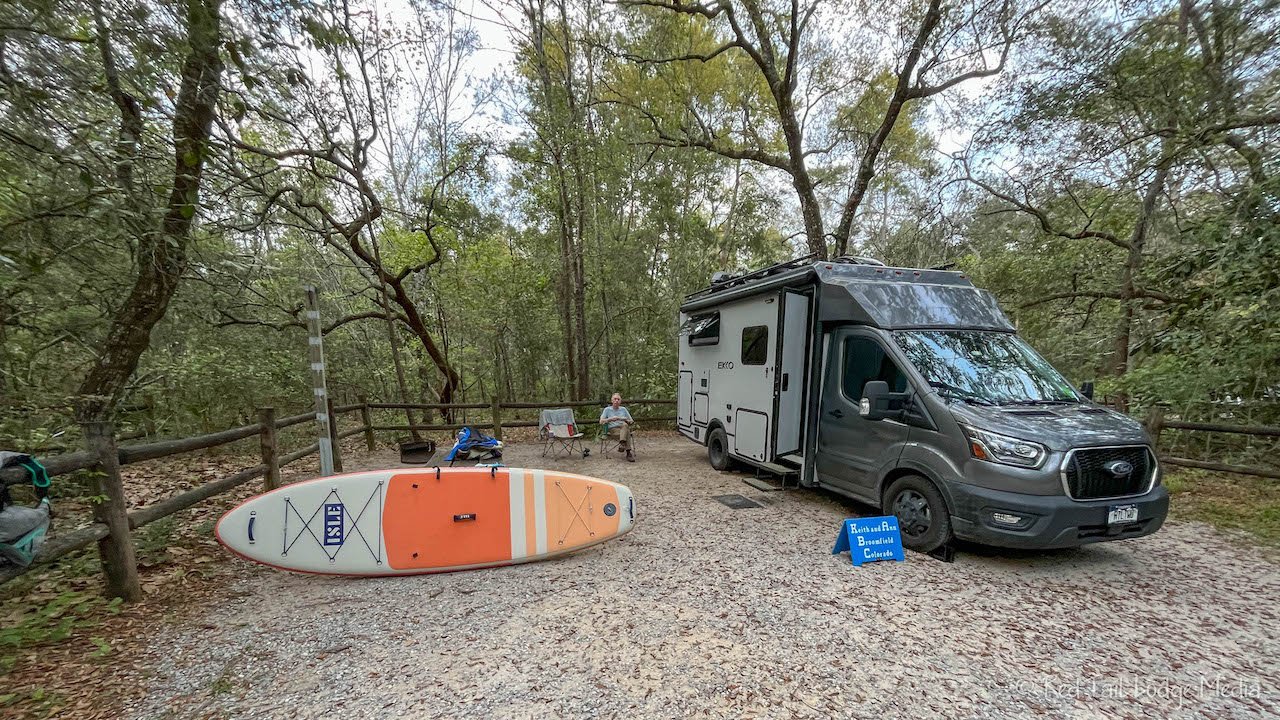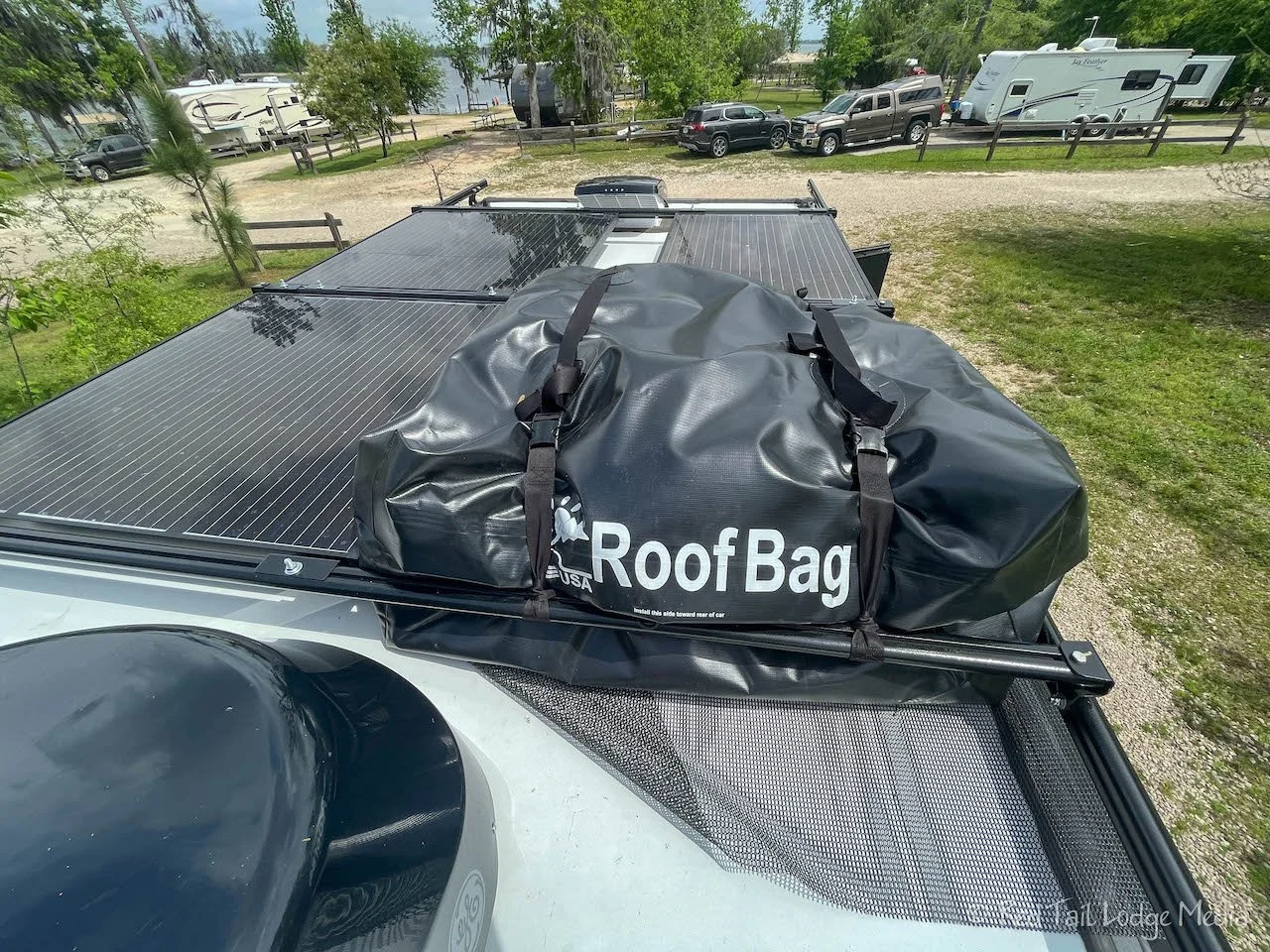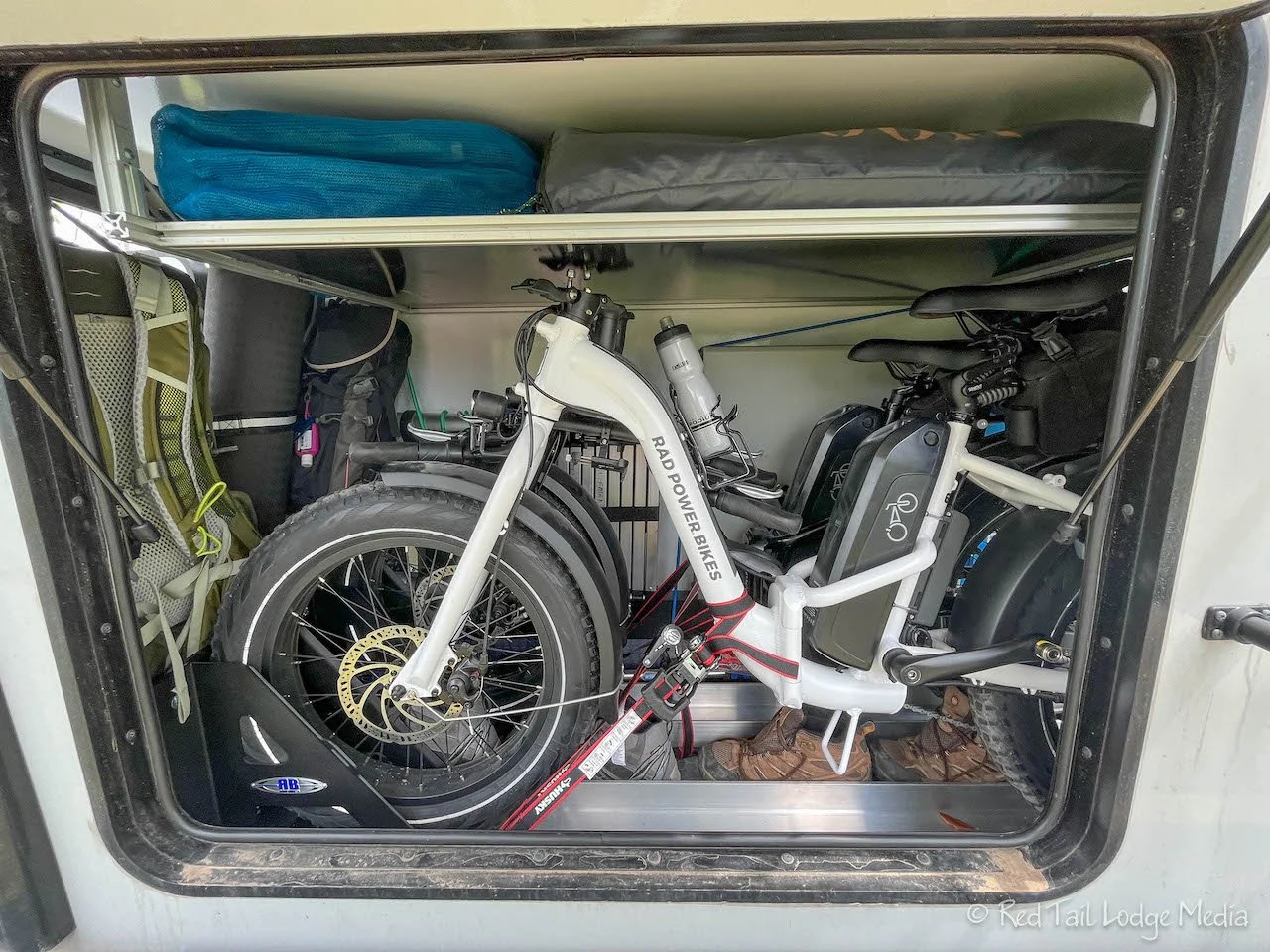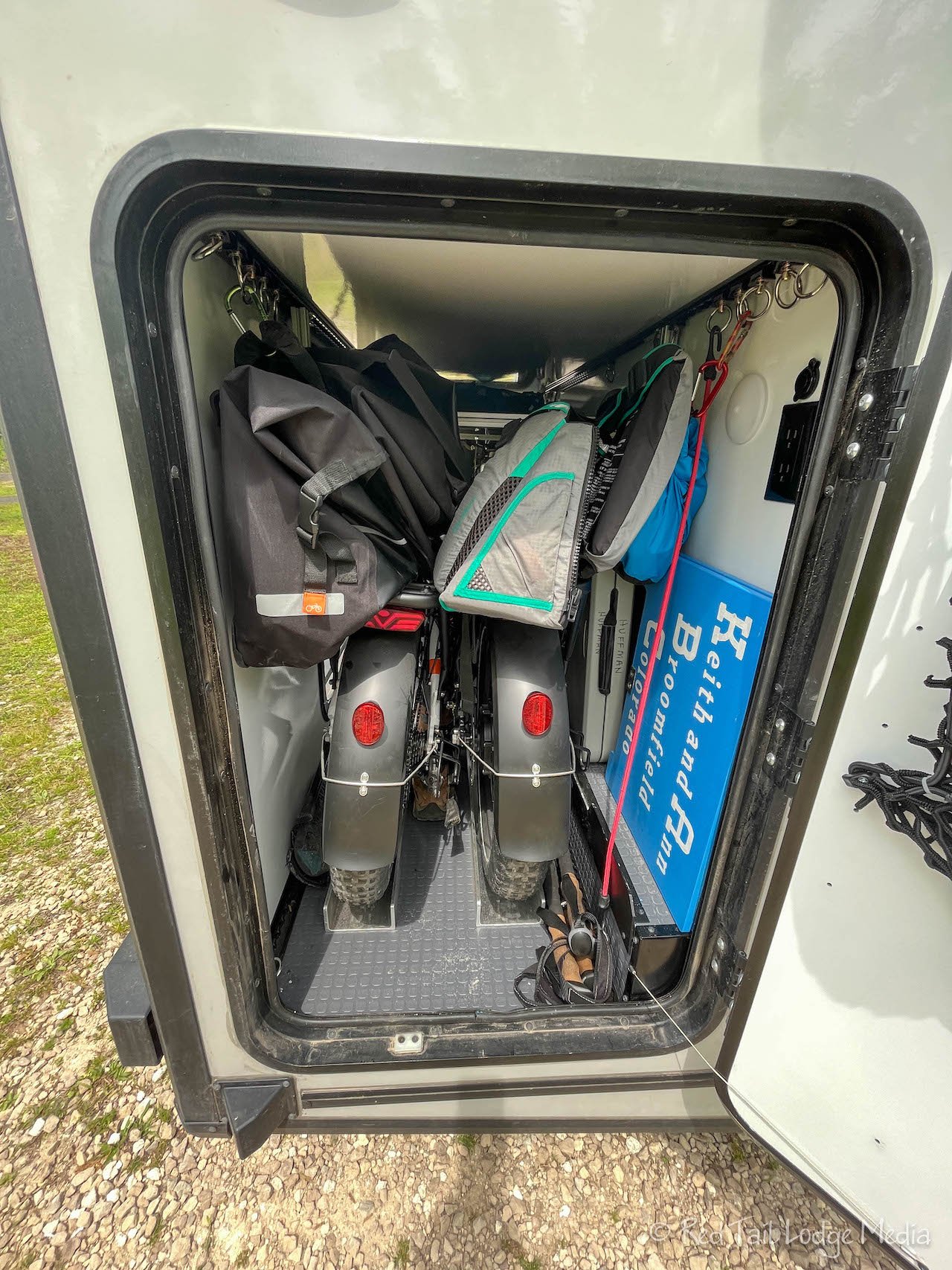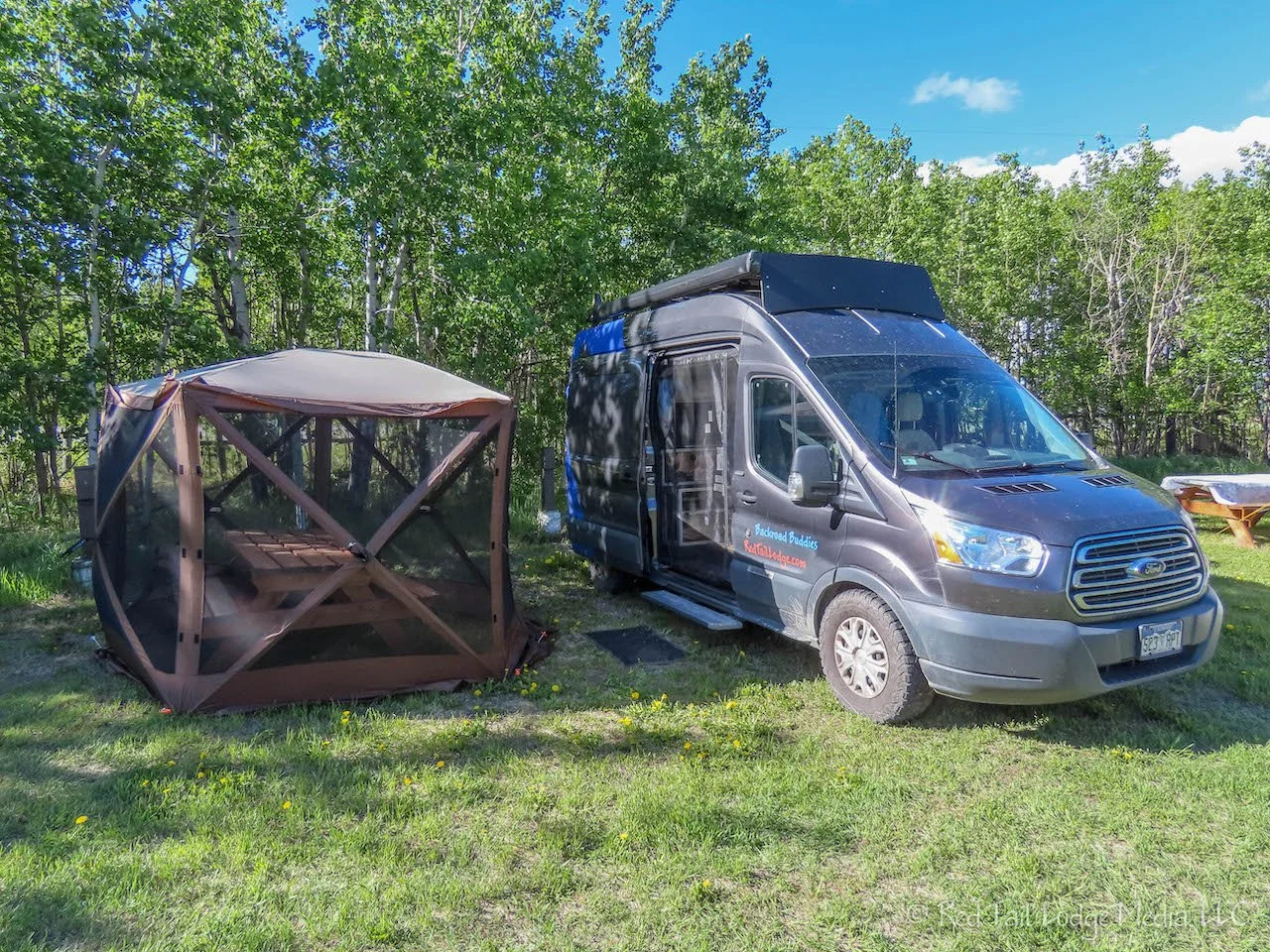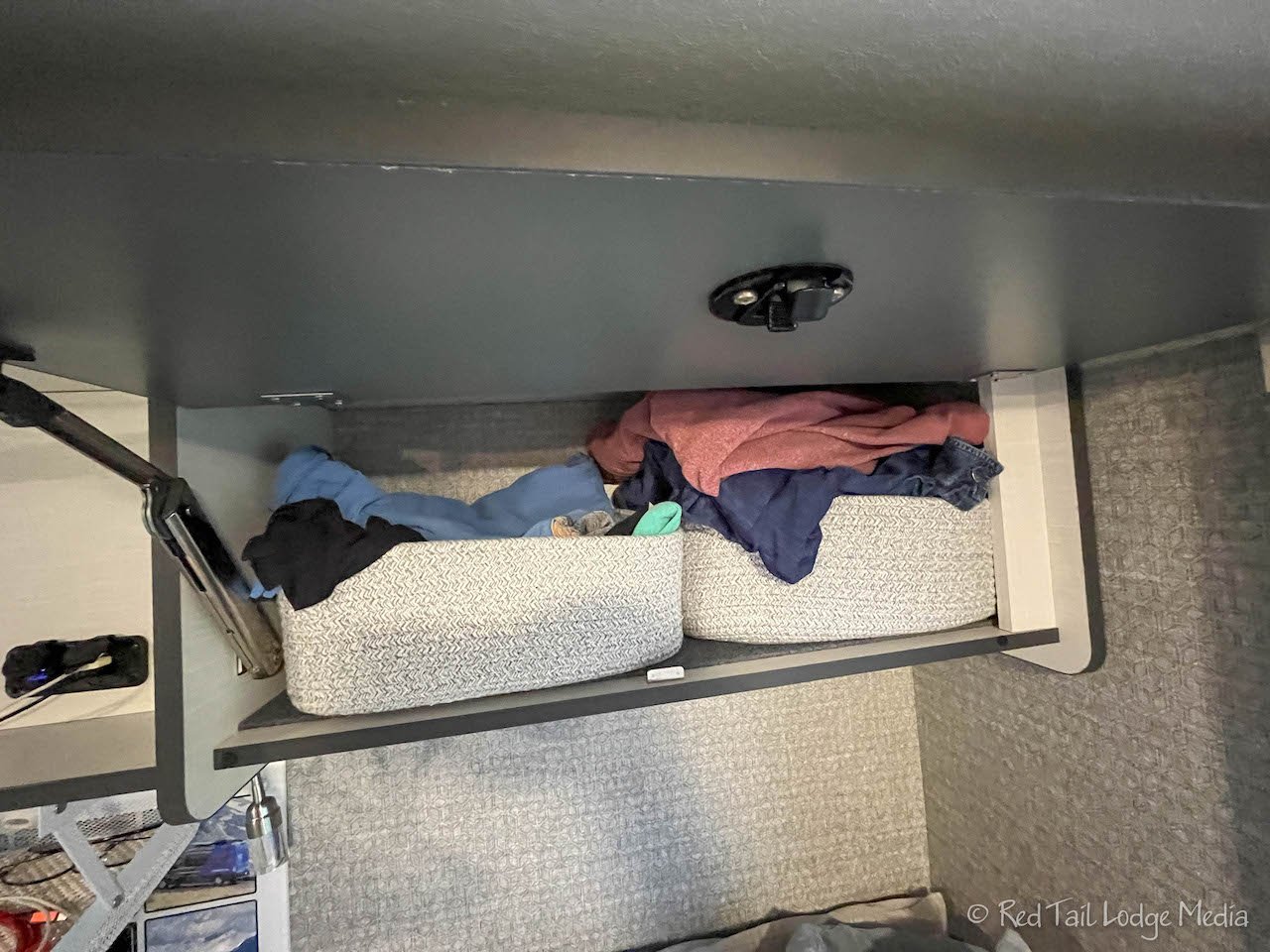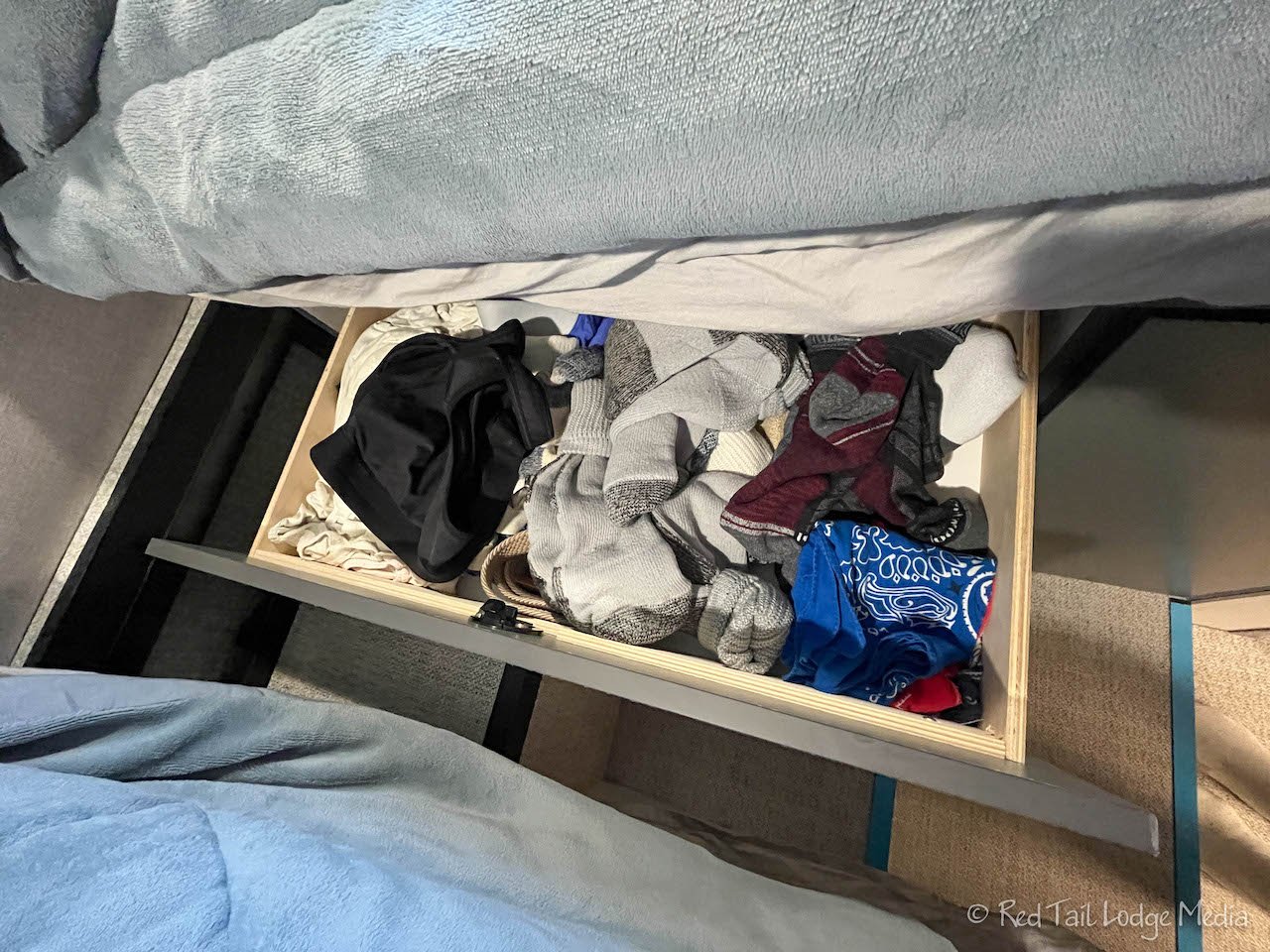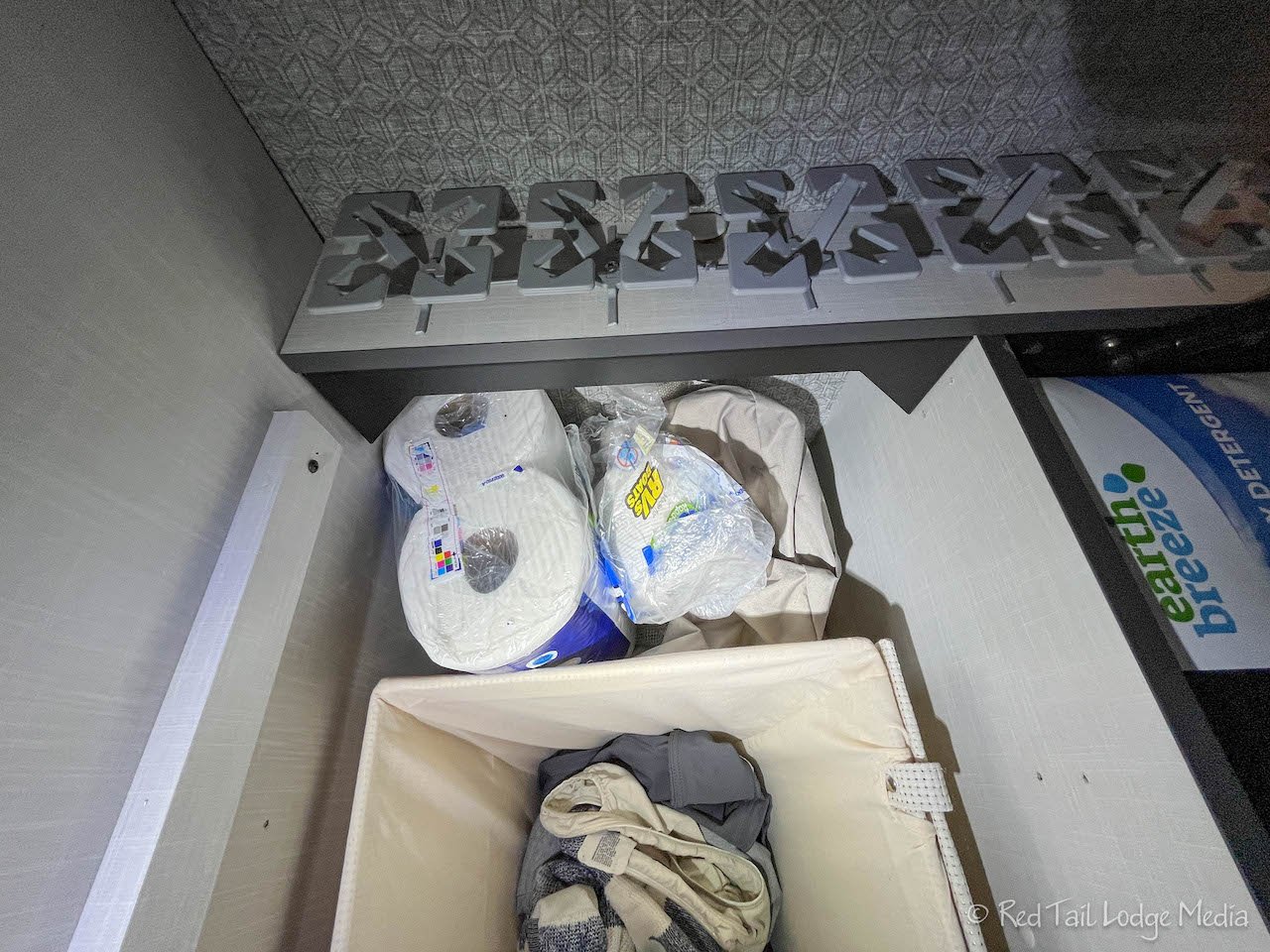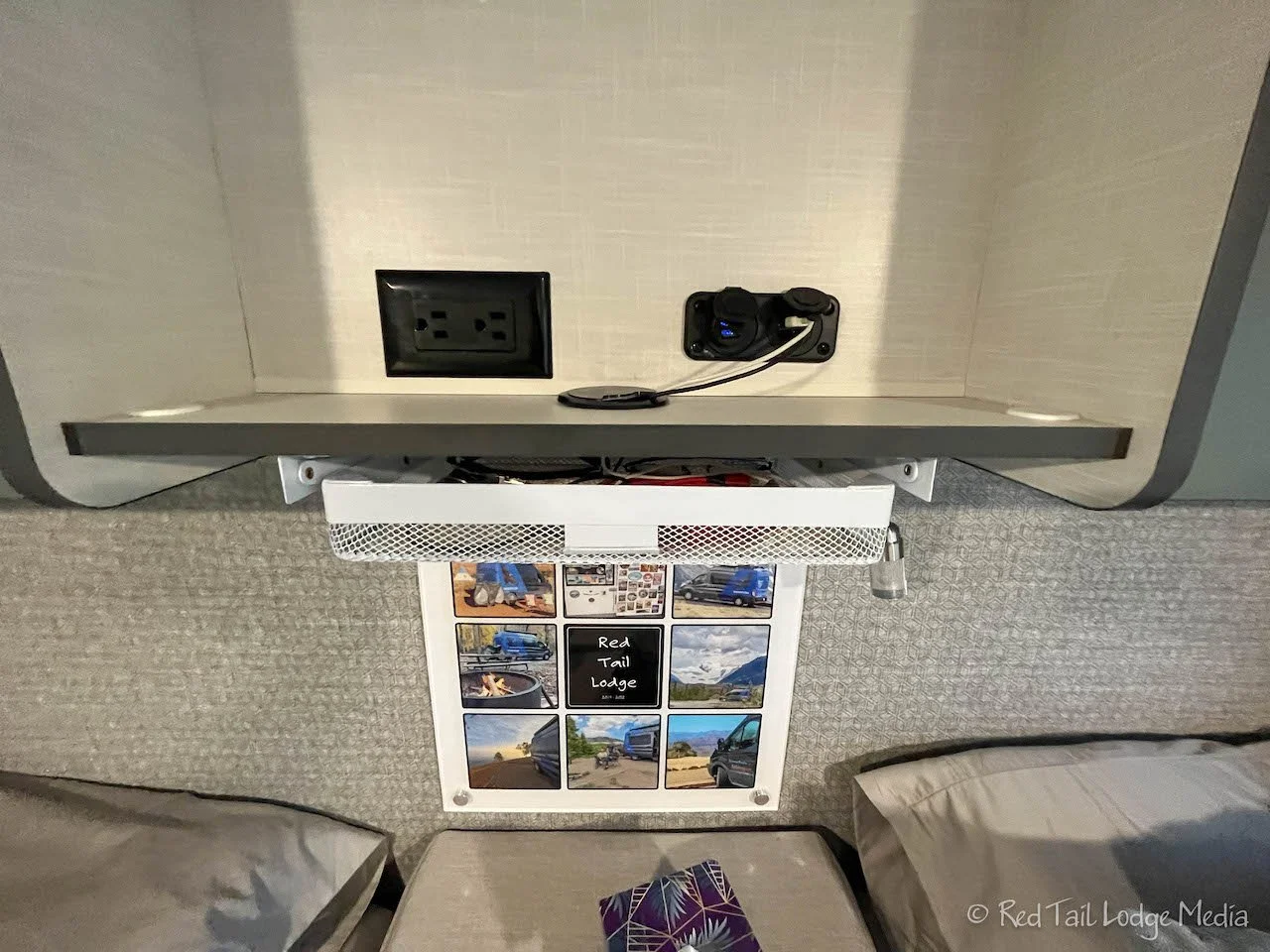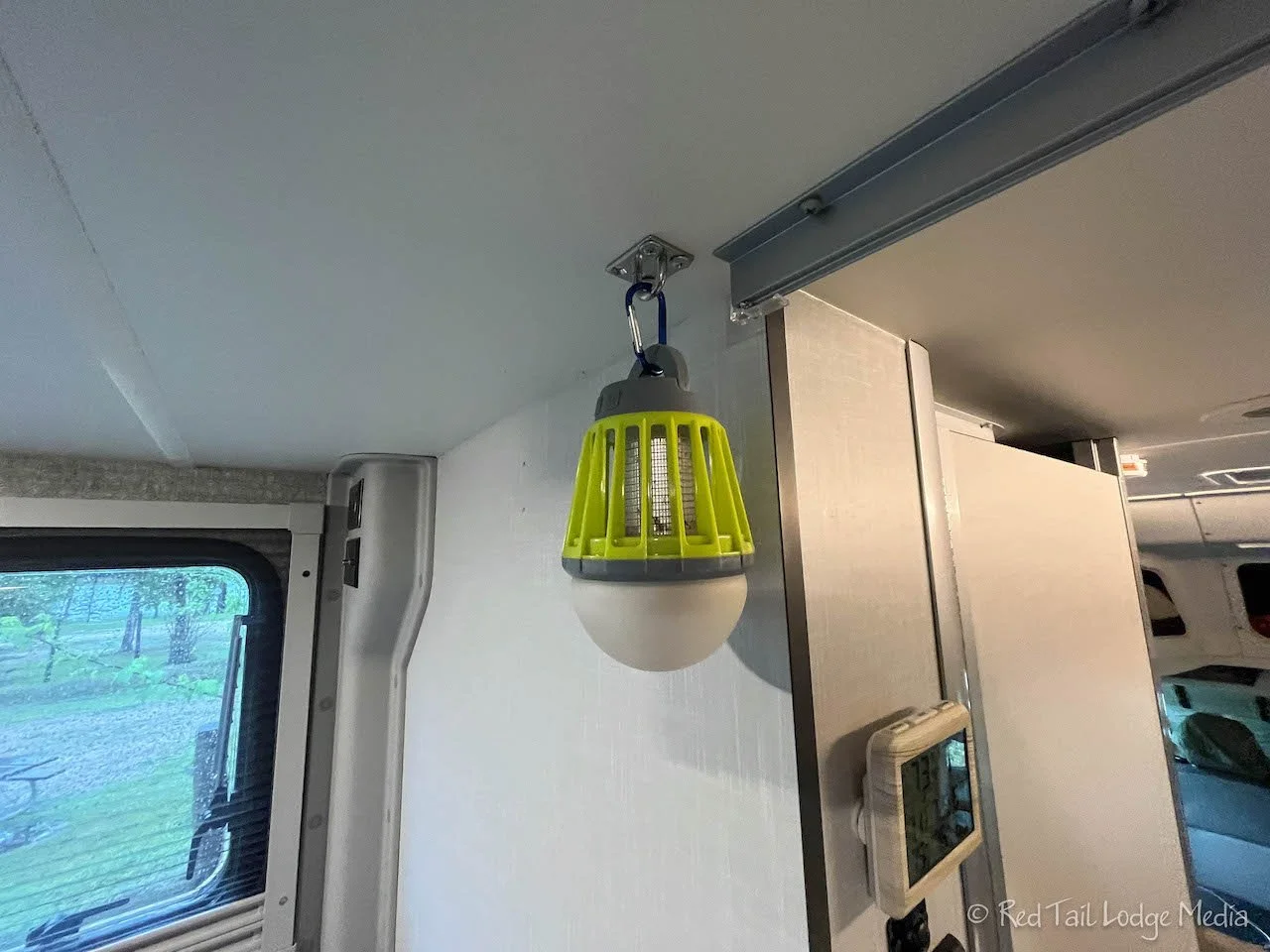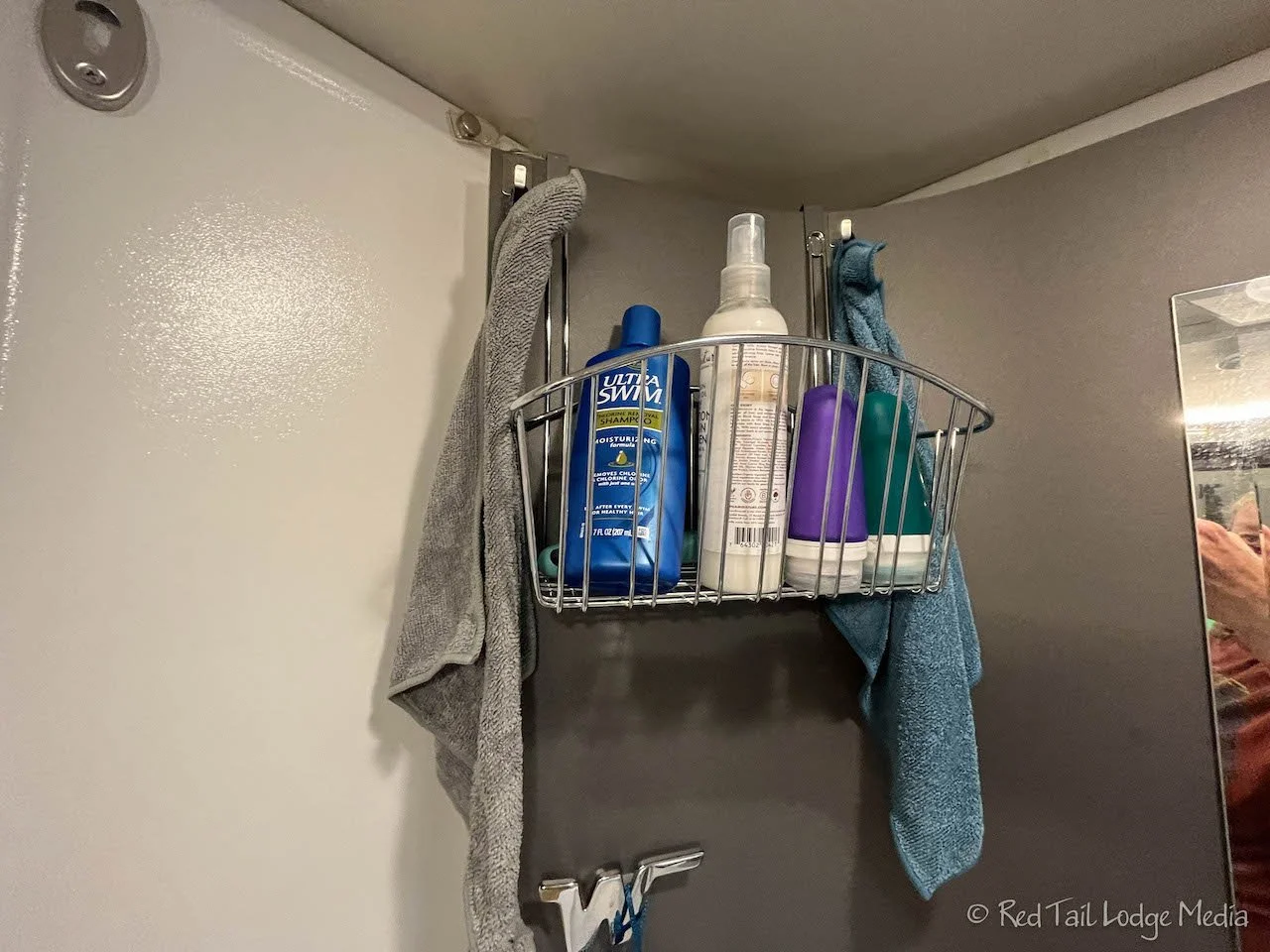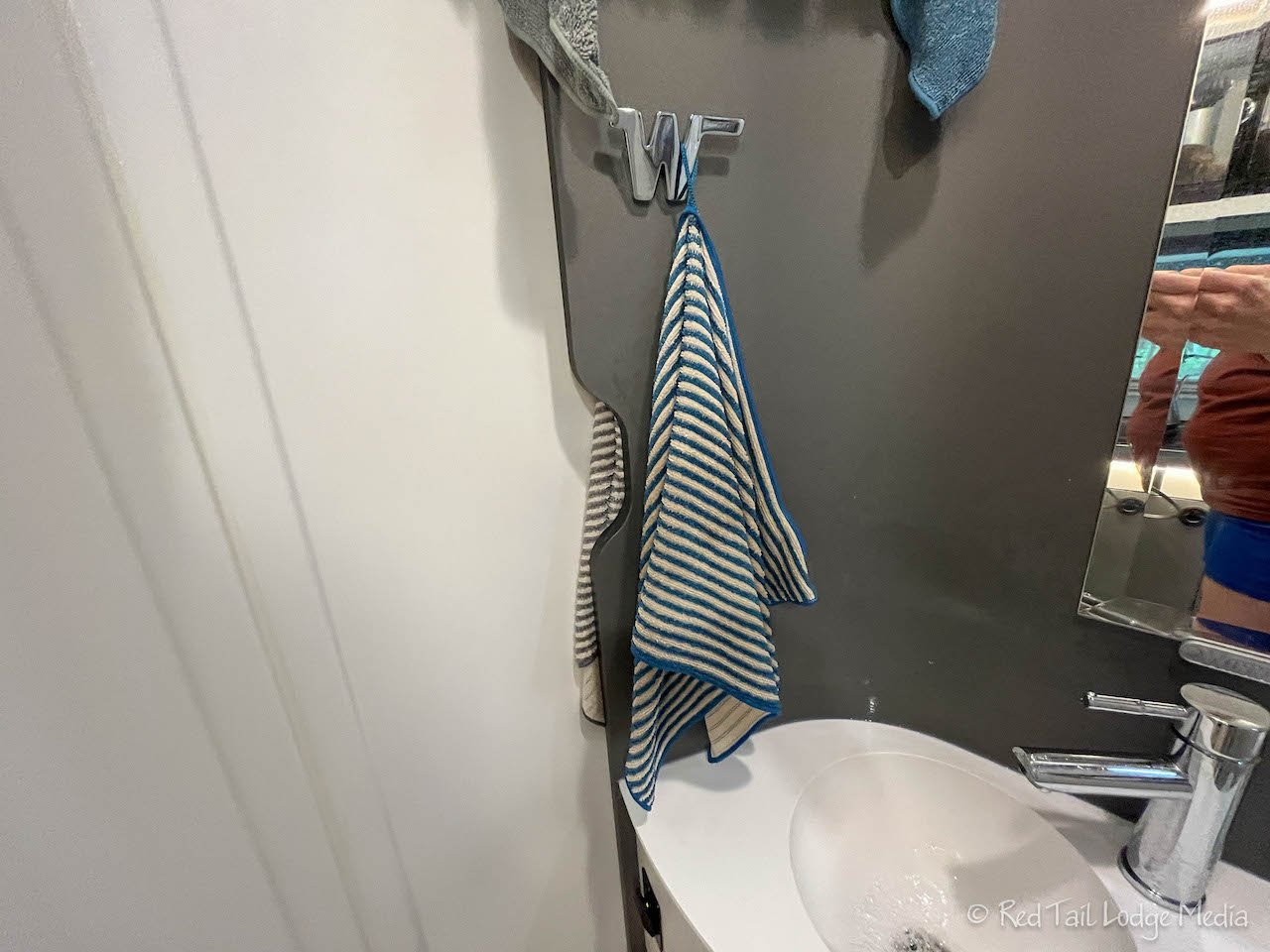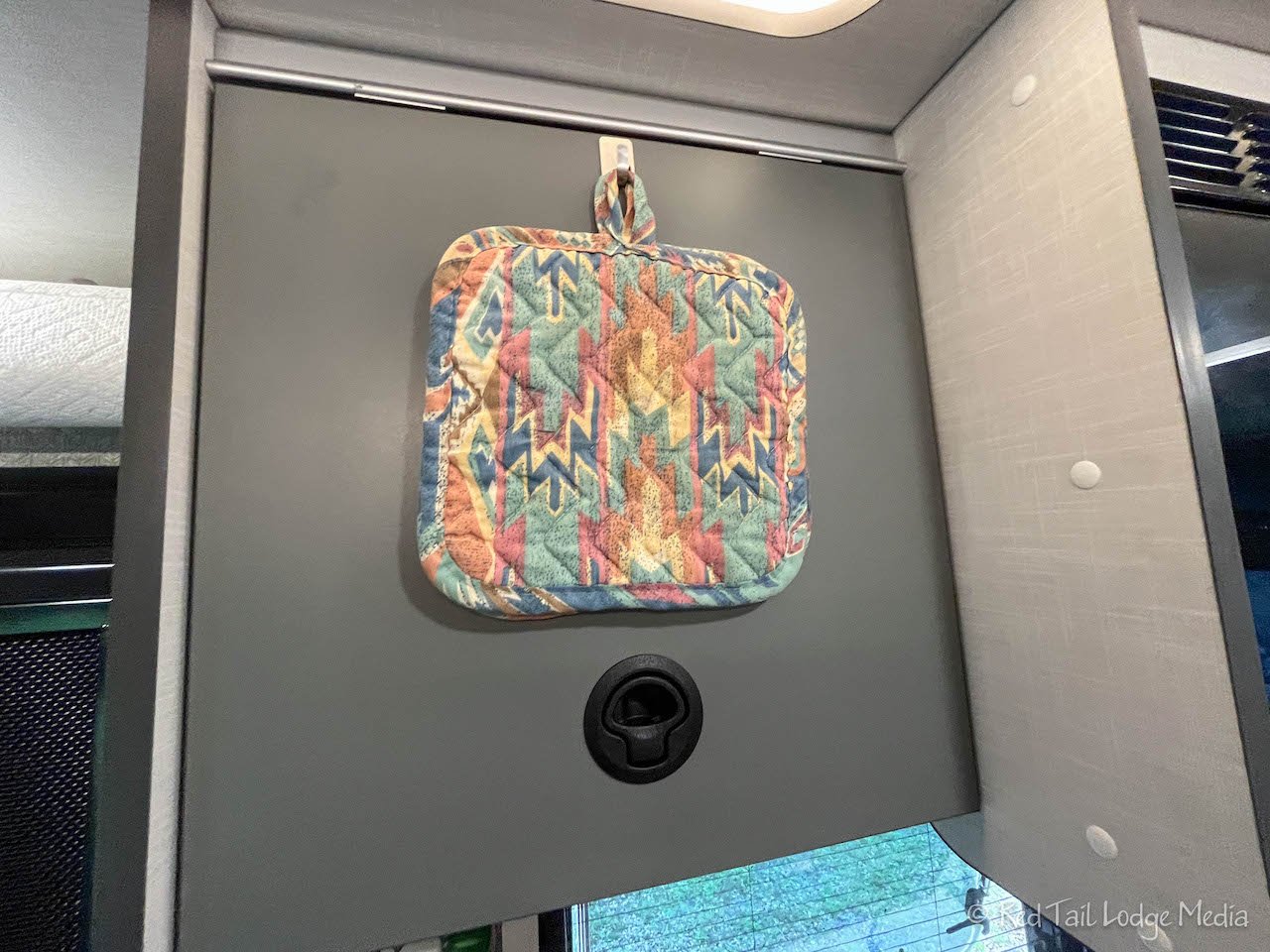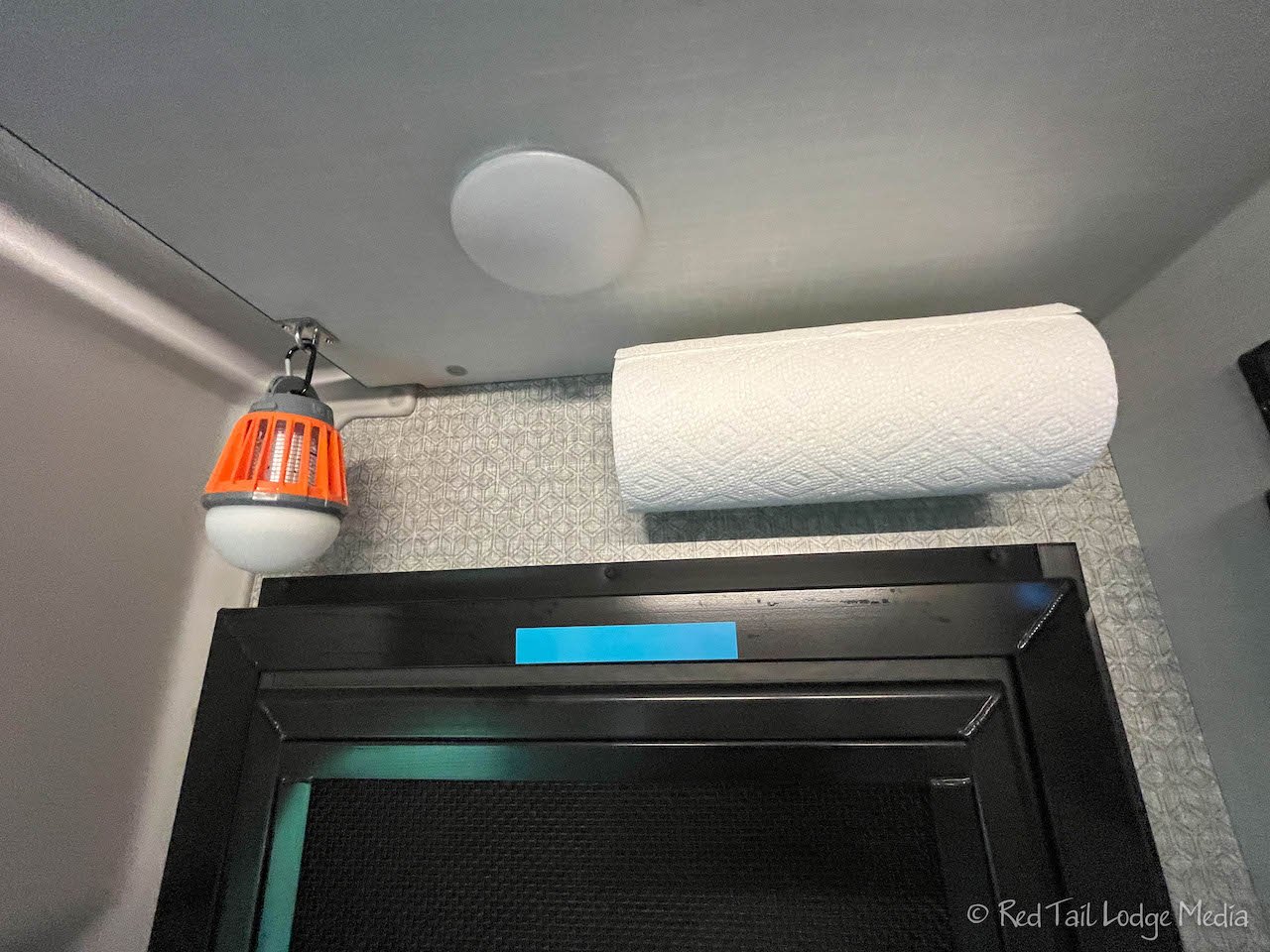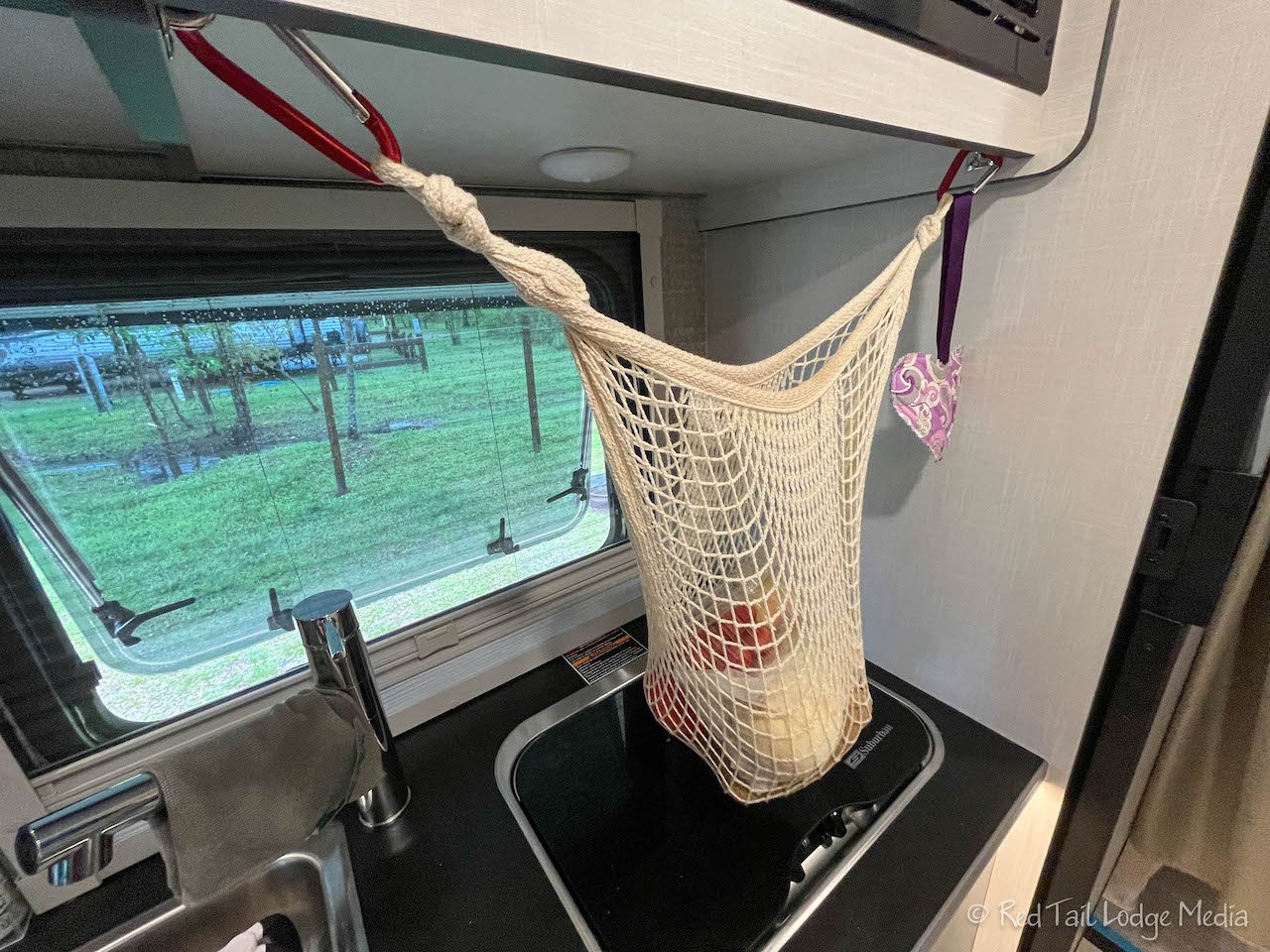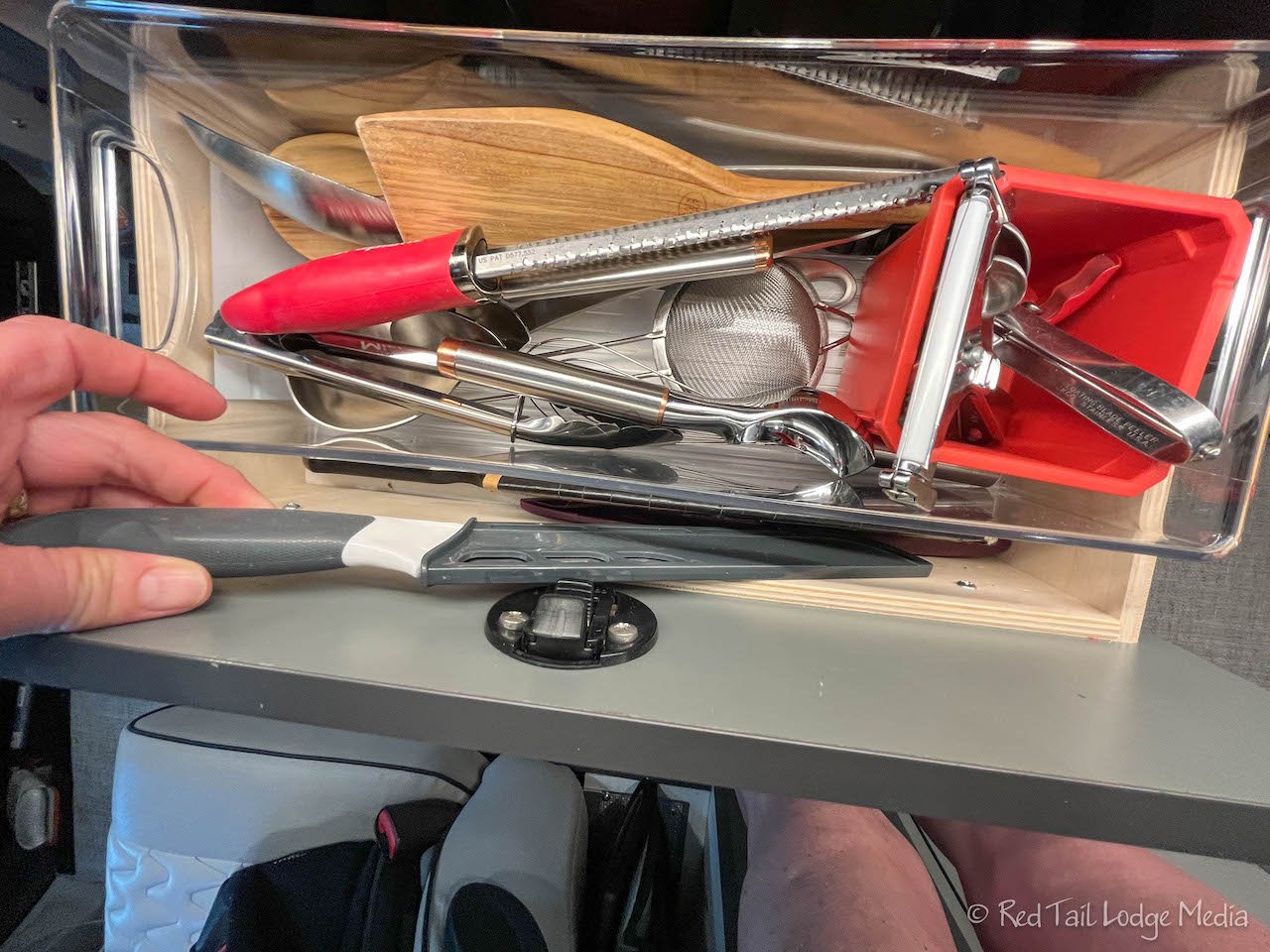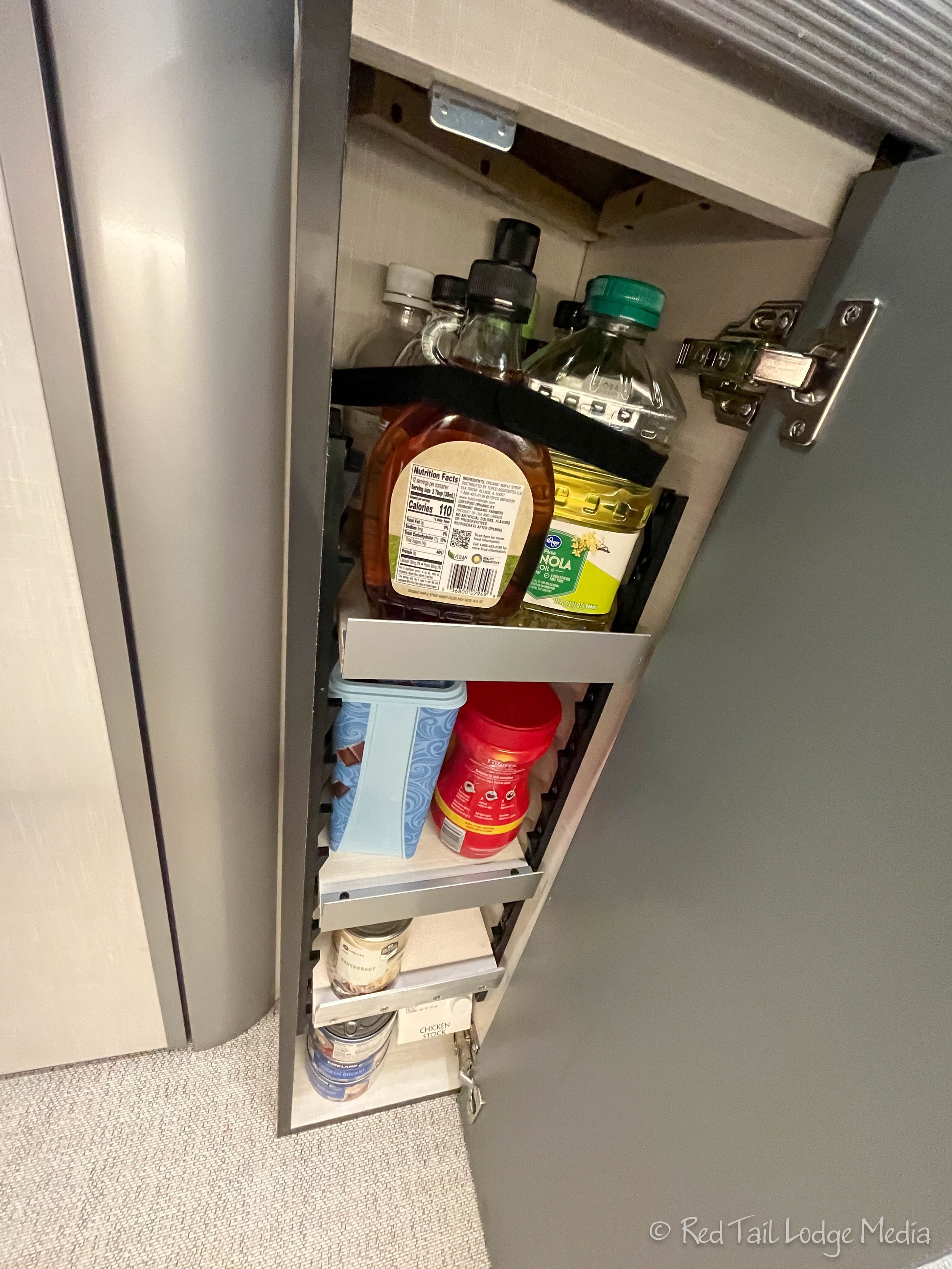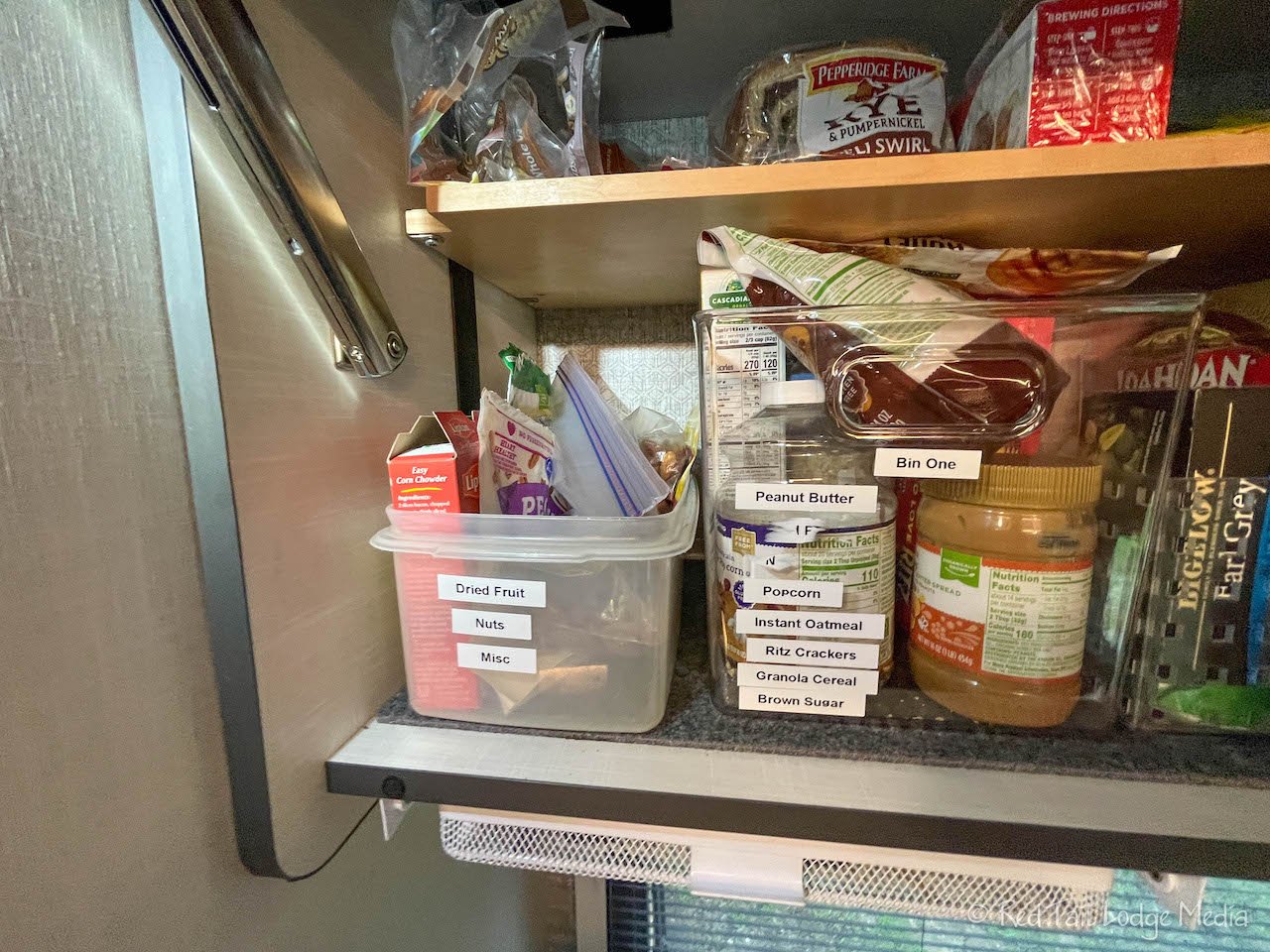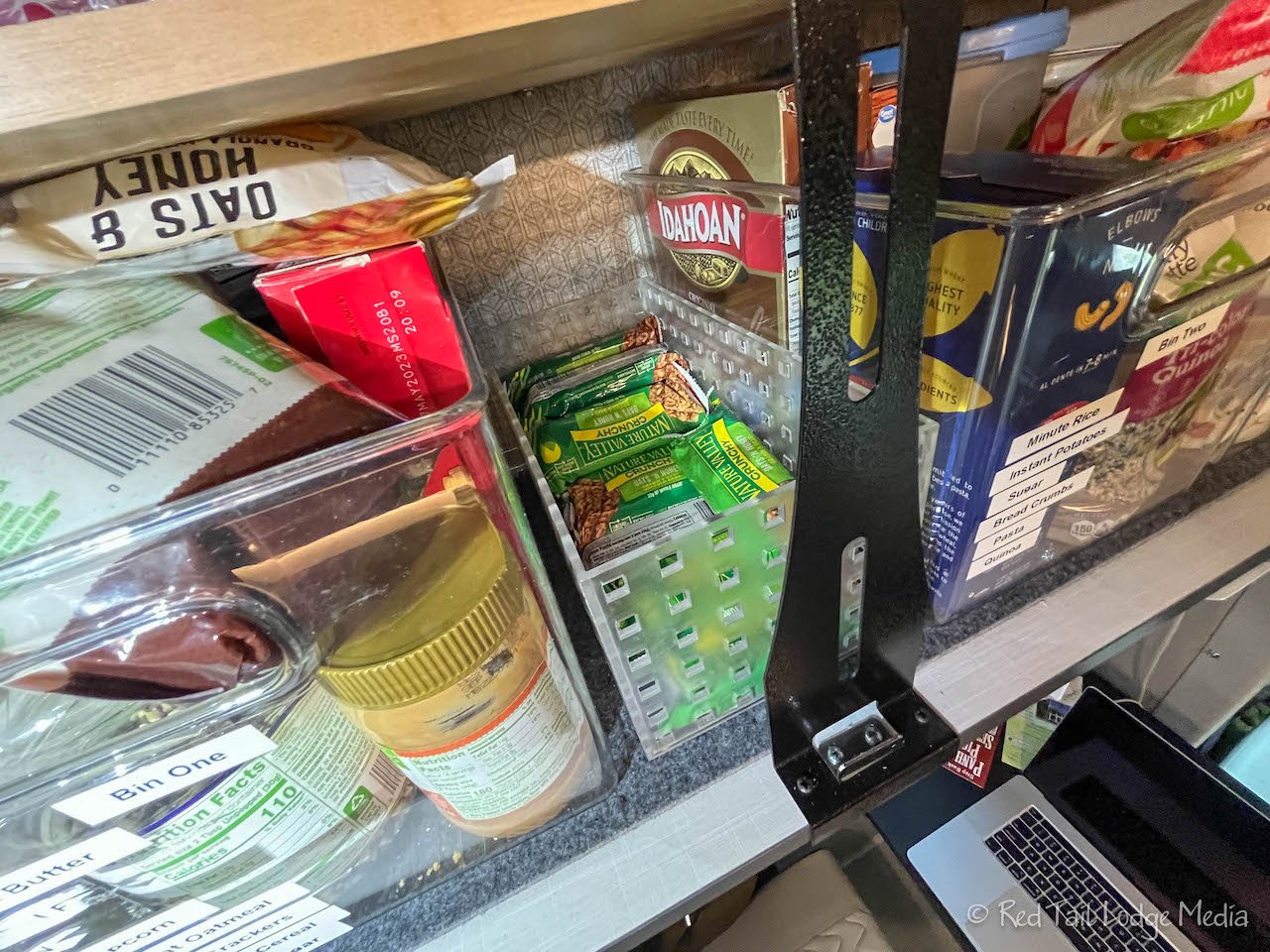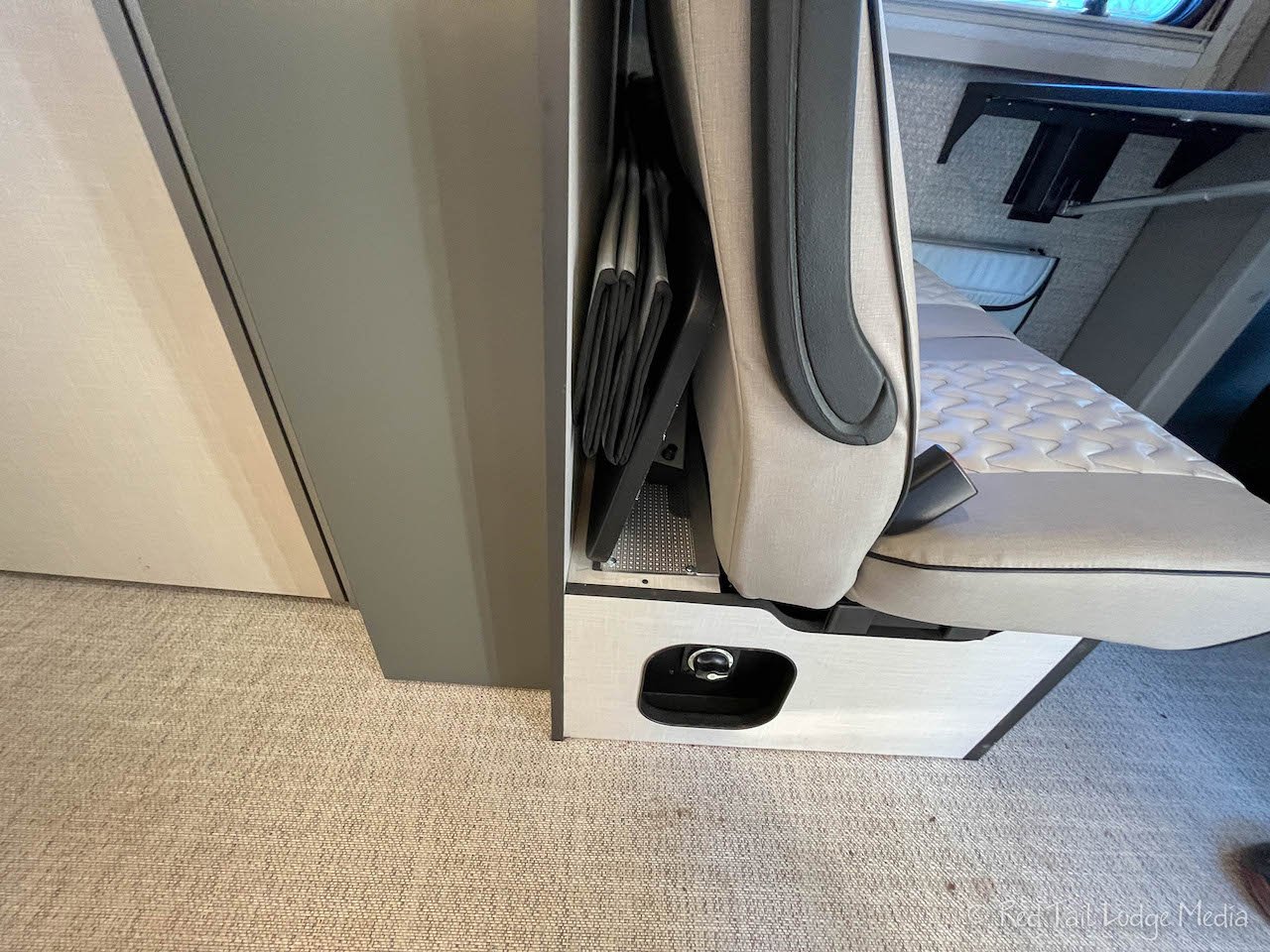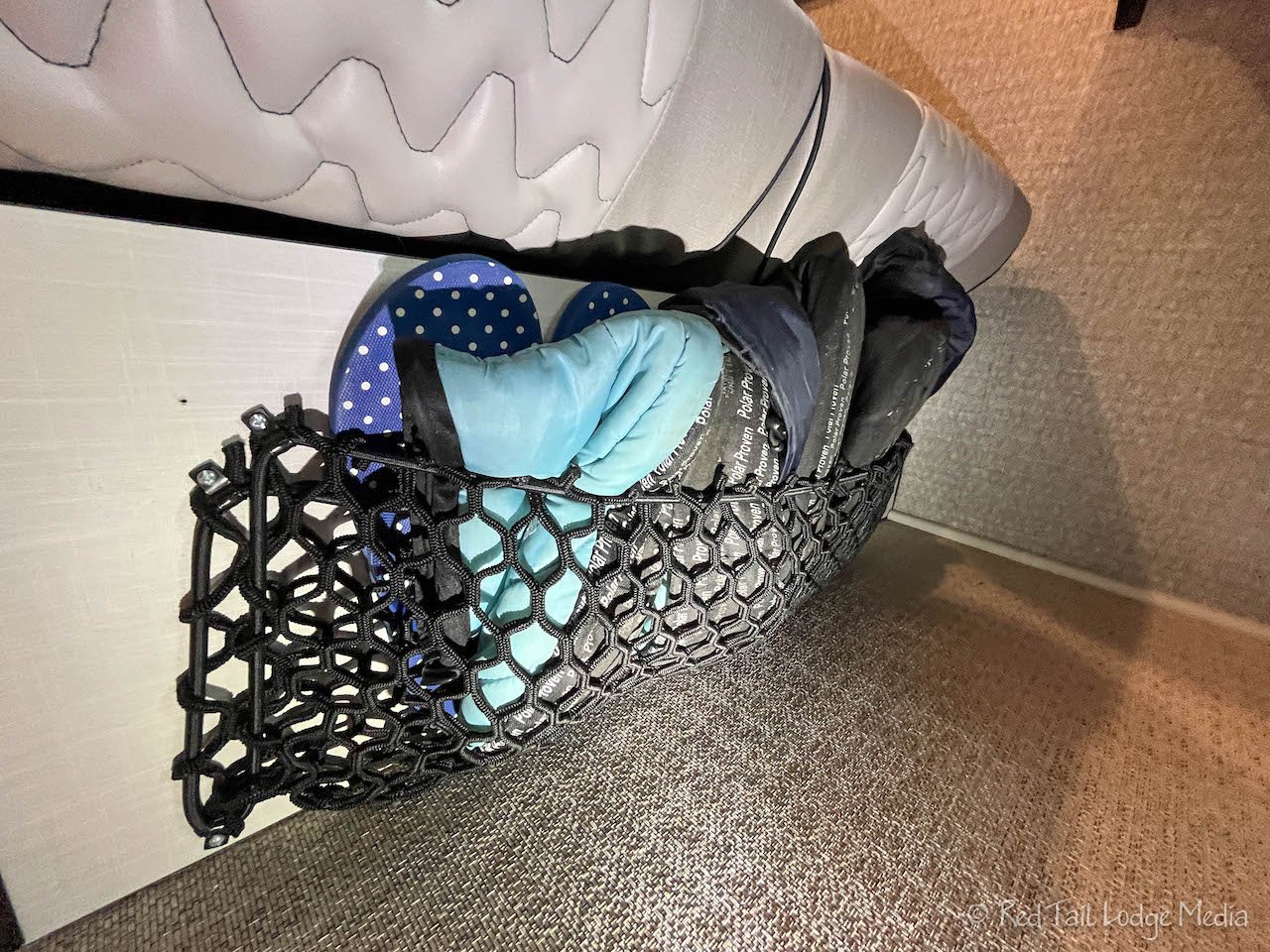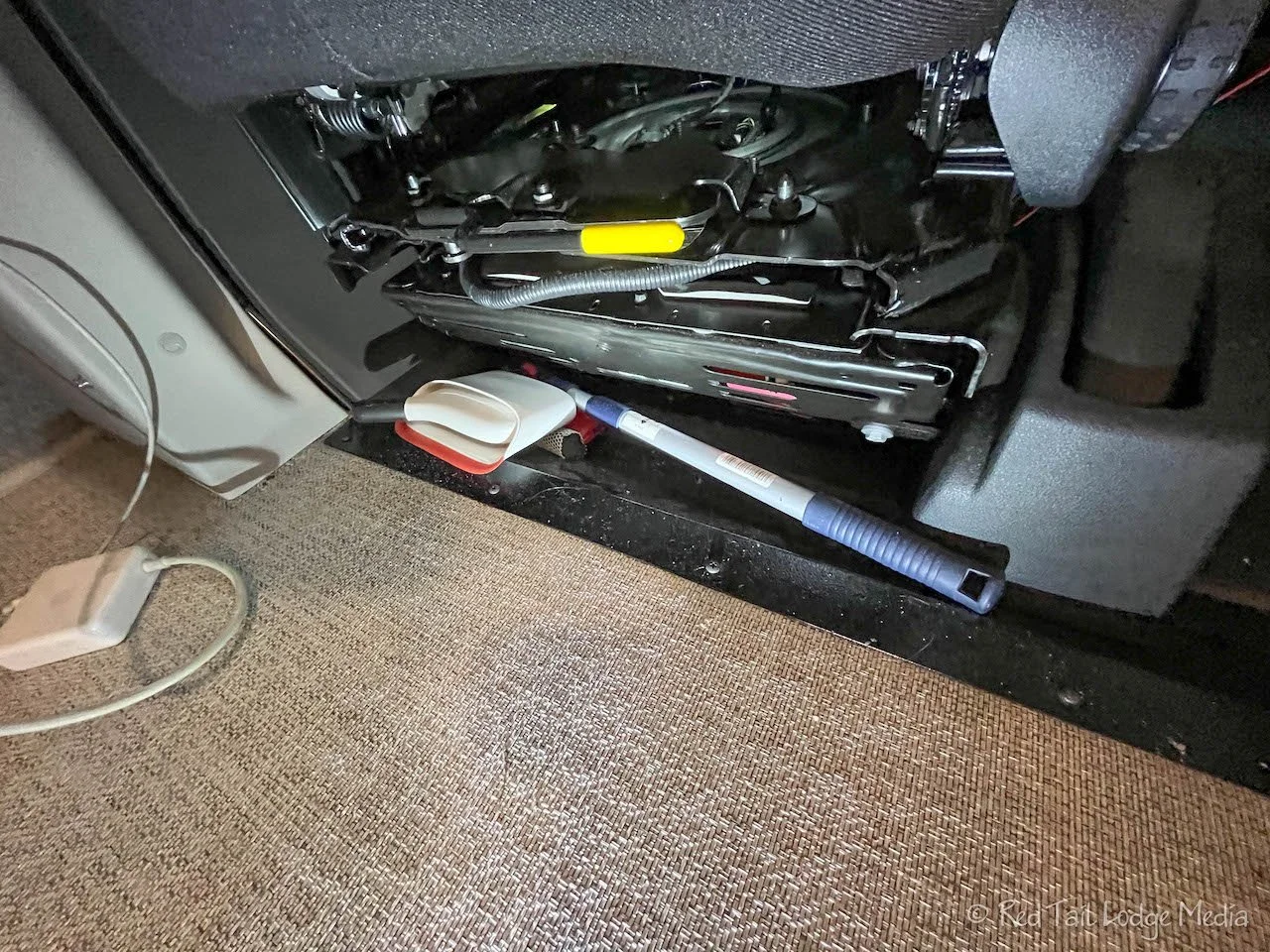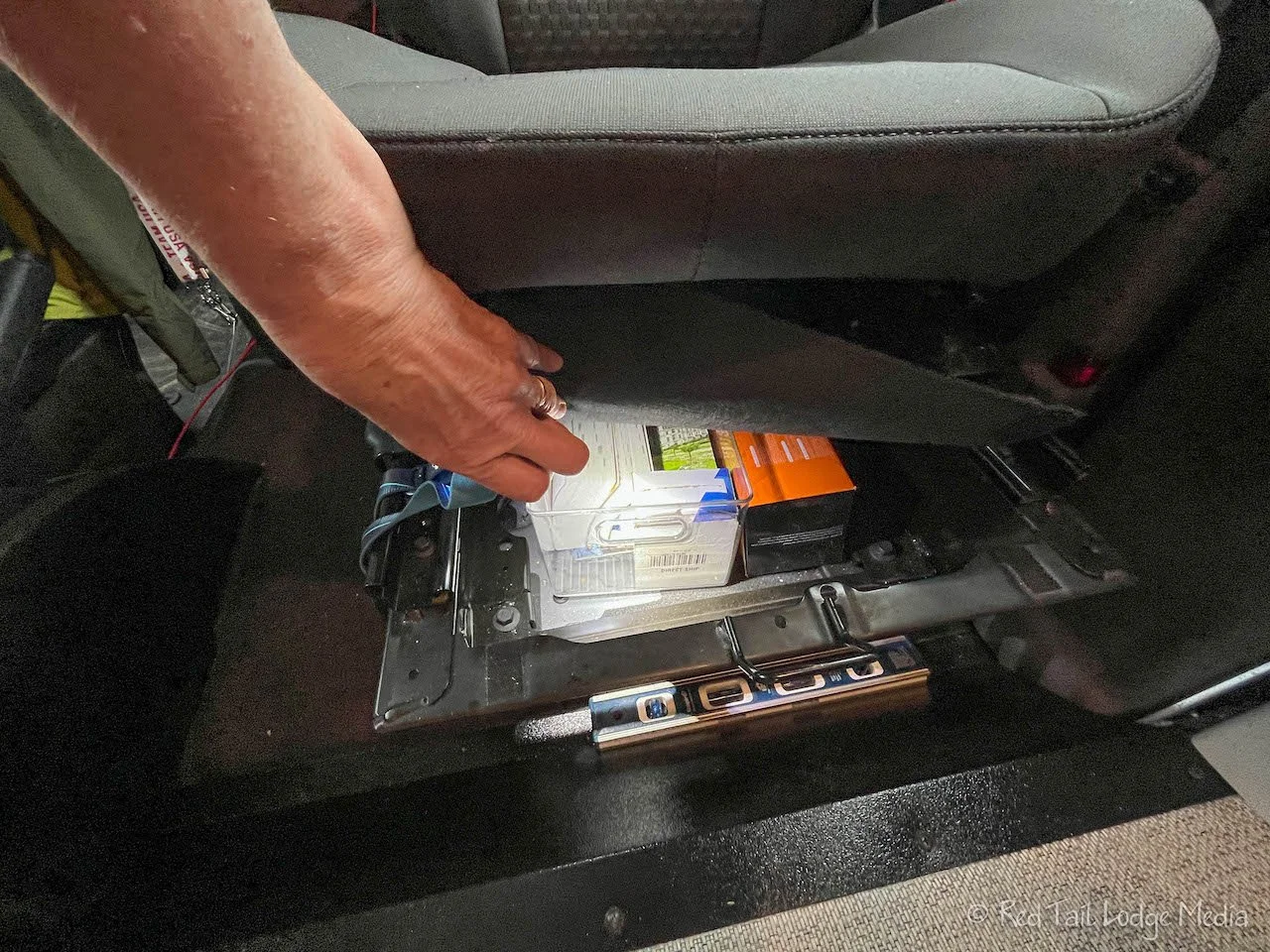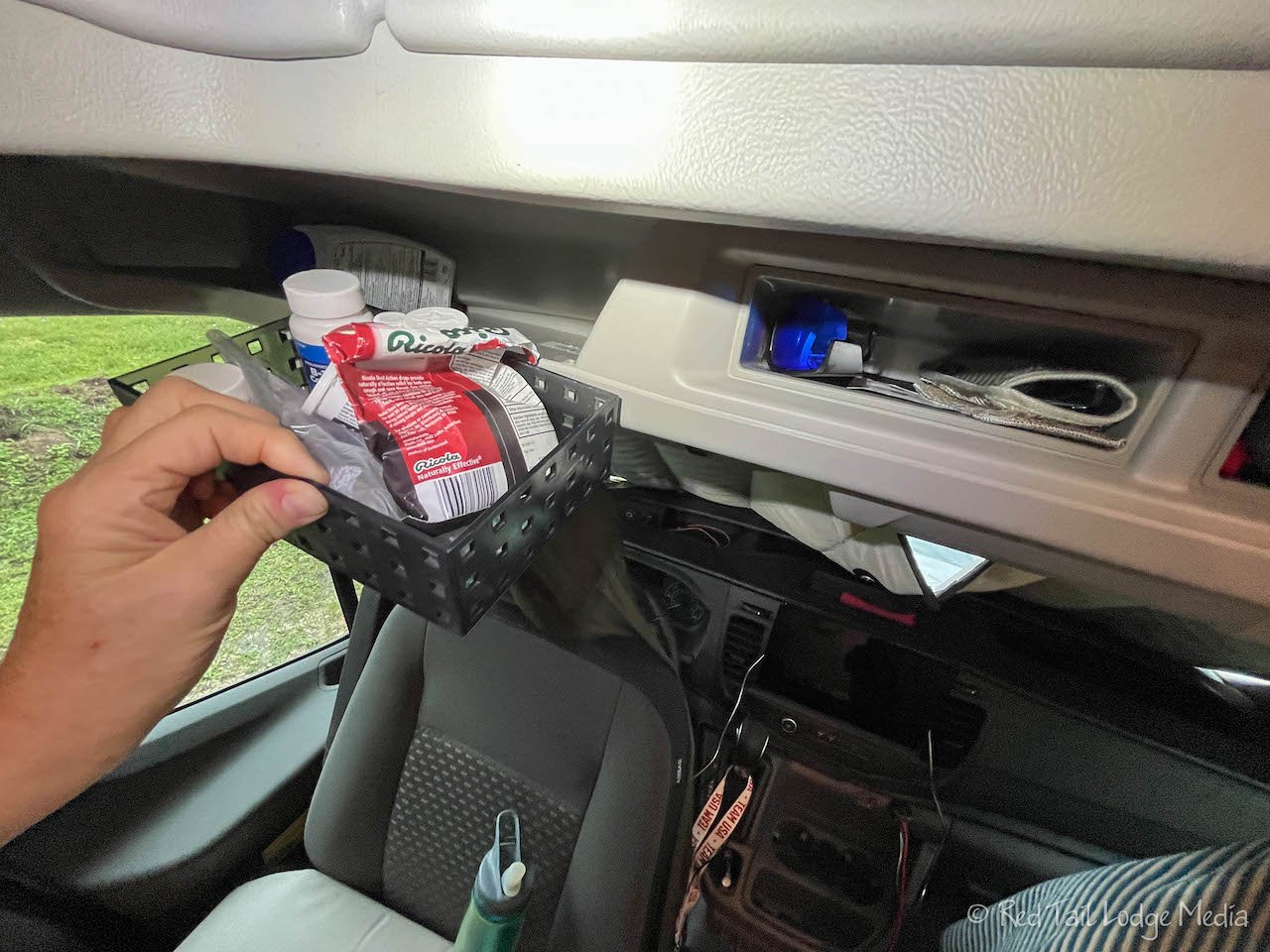Our EKKO Organization
We’re sharing with you what we brought with us for Season Five, where we stored it all in Red Tail, our Winnebago EKKO, and how we keep it all organized. Hopefully it will help you figure out how much stuff can fit in an EKKO, give you ideas on what to bring on a long trip, and provide you with organizational tips. Of course, what you want to take with you will be different from us, but our wish is that you gain at least one good tidbit from us.
Besides the principal of “A place for everything and everything in its place”, there are a couple of other guidelines that we try to follow when organizing our rig. First, we try to store things close to where we plan to use them. Second, we try to keep the things we use the most often, the most accessible. Things that we don’t use or need very often can be stored more out of the way and take a little longer to get out.
We’ll start with the outside storage compartments, one by one, then work our way around the different areas inside the coach. This post is rather long and detailed, so you may want to just jump to a particular section that you are interested in.
One: Generator Compartment
We don’t store anything in the battery compartment, so we’ll start with the Generator Compartment. We did not get the optional generator with our EKKO, so we have the full compartment to use. This is where we keep our tools and items for hooking up to shore power. The tools are for automotive repair and general repair or construction, including our new small power drill (paid link). We’ll cover the details of what tools we bring with us in another post. All the tools are organized in a couple of Milwaukee tool boxes (paid link) along with another plastic divider case. The three boxes stack on top of each other. The Milwaukee containers come with removable bins, which we use in some other places. One of those places is in the Generator Compartment, for tools that we want easily accessible. They also help us better utilize the space. Two areas in the front of the compartment, where the compartment door latches are, need to remain clear to allow the latches to work properly. But the bins are placed in the front and spaced around the latches. To the side of the tool boxes are the RV electrical supplies. These include the 30 amp electrical cord, the Hughes Watchdog Surge Protector (paid link), two different dog bones (a 50 to 30 amp - paid link, and a 30 to 15 amp - paid link), and a 25 foot standard extension cord. In addition, we have a plastic tarp, to try to keep us clean and dry if we need to crawl under the rig for maintenance or repair.
Two: Water Compartment
Working our way around the outside of the rig, the next compartment is the Water Compartment. And what items do we keep in there? Stuff related to water, of course! We mounted the Get Wet Organizer (unpaid link) on the door to hold everything. The items in the organizer include a fresh water hose (paid link) with caps (paid link), blow out plug (paid link), decalcification tablets (paid link) for the water heater, an RV water filter (paid link), the RV water tank filler (paid link), the water heater filter, a water bandit (paid link), the water siphon hose, and a bottle of hand sanitizer. We have hand sanitizer in other places in the rig as well, but we like one here so it is accessible right after we finish dumping the toilet cassette and/or gray water tank. We have the antifreeze kit installed in the water heater which takes the place of the water heater filter. The only time we need to put the water heater filter back in is when we want to decalcify the water heater. In a bucket on the floor of the compartment, we keep a pair of rubber gloves, a couple of rags, and a scrub brush. Also on the floor is the coiled quick release water hose and sprayer. We used the sprayer for washing off equipment, like our paddle board or hiking boots, not for drinking water, so we don’t mind storing it so close to the gray water drain. In addition, we have the key to the toilet cassette compartment hanging on a lanyard from one of the water valves. Since we have to get into the Water Compartment to get the rubber gloves, having the key right there makes it really convenient. We try to reduce the number of keys we actually have to carry in our pockets.
Three: Super Slider
Under our rig, we installed the Super Slider (paid link) to store our sewer hose and the Americanizer (paid link). The Americanizer is used to attache the toilet cassette to the sewer hose for dumping at an RV dump. The original sewer hose that came with our EKKO turned out to be too short. It is supposed to be 10 feet long, but ours seemed way shorter than that. The first campground we stayed at had sewer hookups right at our camp site. But the drain was on the far side of the nice concrete drain area and the sewer hose would not reach. So we bought a 15 foot Camco RhinoFlex sewer hose, but we couldn’t figure out how to store it. The Super Slider would expand to hold the hose, but there wasn’t room under the rig to mount it that long. Either the water compartment or the spare tire were in the way and we didn’t want the Super Slider to sit lower to the ground. Mounting it on the back of the rig or on the roof did not excite us, as we imagined pulling out the dirty hose above our heads, having who knows what drip onto our faces. No thanks! Back to the store we went to purchase a 10 foot Camco RhinoFlex sewer hose (paid link), along with a clear elbow swivel adapter (paid link). We still had to remount the Super Slider, this time at an angle, to avoid the water compartment and spare tire, but everything now fits! We threw away the original sewer hose and gave the unused, 15 foot hose to a fellow camper.
Four: Roof Bag
Moving up to the roof, we store less frequently used items in our new Roof Bag (paid link). Inside the bag is our Isle Pioneer Inflatable SUP board (paid link), paddle, air pump, our two backpacking packs, and our backpacking tent. Inside the packs are the backpacking gear that we don’t need for day hikes, such as bear bags and backpacking stoves. We’ll cover our hiking and backpacking gear in future blog post.
Five: Gear Garage
The Gear Garage is where we store most of our recreational gear. The biggest items are our Rad Expand 5 e-bikes (unpaid link) and all the items associated with them. The e-bike chargers are located on the compartment floor. The bike helmets, bike gloves, and tire repair kit are in a stretch net hanging on the passenger side compartment door. The bike tools are in a bike saddle bag and stay attached to our e-bikes. The water bottles that fit on our bikes, stay on our bikes after they are emptied and dried. Our two bike panniers hang from the L-track and contain our bike locks, quick release pedals, and bike air pump (paid link).
Then there is our hiking gear. Our small and medium backpacks (paid link) hang from the L-track and contain most of our hiking gear, so all we have to do is add rain gear, food and water and hit the trails. Again, we’ll cover what gear we take with us on hikes in a future blog post. Our hiking boots and trekking poles (paid link) live on the floor of the garage.
There is also some paddle board gear that we keep in the gear garage. This includes a life jacket (paid link) and dry sacks which hang from the L-track. Inside the dry sacks are our waterproof and floating pouches (paid link) to hold our phones while out on the water and our camera floats (paid link). On the floor of the garage are Ann’s surf shoes and Keith’s Teva sandals.
On the top shelf that we built, we store long items, like our two camping chairs, our Moon Shade (unpaid link), and our sand-free mat (unpaid link). The new suction cups that we bought for the Moon Shade are stored inside the Moon Shade bag. However, the new Moon Shade anchors are rather pointy, so we store them on the compartment floor to avoid the risk of puncturing holes in our Moon Shade.
On the narrow lower side shelf, we have our folding camping table (paid link), two small stadium seats (paid link), a telescoping ladder (paid link), and our camp site sign. Bungee cords help to keep the items in place, although the gear garage is packed so full that they really done’t have much room to move anywhere. To complete the list is Ann’s yoga mat (paid link), a bag of bungee cords, and a bag of ropes.
The one thing we could not find room for was our Quick-Set screen shelter from Clam (paid link). It was just too big to go anywhere, packed up it is 7.5 inches by 7.5 inches by 62 inches (5 foot 2). The only compartment long enough hold it is the gear garage, but after the e-bikes are loaded, there is no room. The shelter is too thick to go on the top shelf, besides, there’s no space left on the to shelf. We thought about tying it to the outside, but it would just stick out too far. It’s wider than the back bumper. There is no place to put it on the roof. We could put in on the floor inside the living space and pull it out when we set up camp, but it would be in the way whenever we stopped on the road. Unfortunately, we decided to leave it at home.
Six: Exterior Kitchen Compartment
Moving on to the last exterior compartment, we have the Exterior Kitchen Compartment. Since we removed the Tailgate package, we have full use of the space inside this compartment. There are still outdoor kitchen stuff in here, but a whole lot more. This is where we store our Blackstone Griddle (paid link) and all of its accessories. They include two squirt bottles (one for oil, one for water), a protective wood plate, cooking tools (paid link), extra grease pan with spare liners, and the propane quick connect hose. The oil is used for cooking and seasoning the griddle. The water is used to clean the griddle. The cooking tools include two metal spatulas, a metal scraper, and tongs, which we store inside of a zippered pouch to stay clean. The extra grease pan is used to hold the two squirt bottles upright. Plastic bags are wrapped around both grease pans to keep them from spilling anything inside the compartment. In addition, we have a zippered pouch that contains our picnic table cloth, bungees, and clips along with another zippered pouch for our Thermacell, citronella candle, and a lighter. For outdoor cooking safety, we have an Element Fire Extinguisher (paid link).
The Kitchen Compartment also holds stuff for leveling the RV. We have two pairs of GoTreads traction boards (unpaid link) inside their zippered bags, plus four 2x6 boards and one pair of wheel chocks. We use the GoTreads when we need to raise a wheel two to four inches. We use the boards when we only need to raise a wheel an inch or two.
The Kitchen Compartment contains some roadside emergency equipment. This includes a Viair air compressor (paid link), an auto tire repair kit (paid link), a tire depth gauge, an emergency shovel (paid link), a NOCO emergency starter battery (paid link), a safety vest, two emergency beacons, two emergency triangles, and a 25 foot tow strap.
The last couple of items in the Kitchen Compartment are a folding step stool (paid link) and a dust buster (paid link) along with its charger.
Seven: Bedroom
Moving inside the rig, we’ll start in the back and work our way forward. Starting off in the bedroom, we have our sheets, pillow cases, comforters, and four pillows on the two beds. We like not having to make the beds every evening and put them away every morning like is true for some RV’s and camper vans. We do still have a little bit of that “camper van shuffle” as we usually move the two spare pillows to the dinette every night before going to sleep. We like the extra pillows for back support when we sit up in bed in the evening, watching YouTube videos, but they get in the way while sleeping. We both store our PJ’s under our sleeping pillows.
In the wall cabinets, we store clothes. For Keith, the one on his side holds all his shirts and pants. Ann travels with more clothes than that. To give you an idea, in her wall cabinet, she has 10 short sleeve T shirts, three long sleeve T shirts, four hiking shirts, one jeans shirt, one thin thermal top, two medium weight thermal tops, and one fleece top. She uses two soft bins (unpaid link) to make it easy to pull them down and find the shirt she is looking for.
We each have a drawer under the beds. In Ann’s drawer, she has 10 pairs of socks, four pairs of hiking socks, two bras, four sports bras, 10 pairs of underwear, 4 pairs of hiking underwear, and three bandanas along with a belt (when she is not wearing it).
Inside Ann’s wardrobe cabinet is where she stores all her pants, shorts, and shoes. In the cloth bin (paid link) on the top shelf are two pairs of hiking pants (one thick, one thin), two pairs of jeans (one thick, one thin), two pairs of leggings, one pair of cargo shorts, three pairs of spandex shorts/spanks, two bathing suits, padded bike shorts, thermal underwear (tops and bottoms), and one nice outfit which consists of a skirt and a nice top. In the plastic bin (unpaid link) on the bottom shelf are two pairs of trail runners, one pair of Teva sandals, and a nice pair of flats. She’s hoping she can keep the dirt and sand off her nice shoes. Keith does not store his shoes in this bin. He is usually wearing his trail runners while his only other pairs of shoes, his hiking boots and sandals, are in the Gear Garage.
In Keith’s wardrobe cabinet, we have our laundry basket (unpaid link) and laundry backpack (unpaid link). Behind the laundry basket, we also store one of our sleeping bags along with a compression sack, an inflatable pillow and inflatable sleeping pad. These are for backpacking. We didn’t feel comfortable storing these items up in the Roof Bag with our other backpacking gear. We were concerned about the Roof Bag leaking or gaining moisture from our paddle board gear and getting our sleeping bags wet. And we would not realize that it happened until we got them down to use them, which would be too late to do anything about it.
The other sleeping bag, pillow, compression sack and sleeping pad are stored in the deep well, also under Keith’s bed. In addition, we put the extra toilet paper and paper towels behind the laundry basket.
For laundry detergent, we switched to something new this season, laundry detergent sheets. They take up less room and you don’t have to worry about a liquid or powder leaking out onto other things. We keep one box of the sheets in a pouch on the side of the laundry backpack. The spare box fits in the shallow tray under Keith’s bed.
There is also a shallow tray under Ann’s bed. This is where we store our extra dish towel, dish cloth and hand towel. Our FMCA sticker also resides there. We’ll need the sticker later in the season when we camp a couple of nights at the FMCA (unpaid link) campground in Cincinnati, Ohio.
We each have a soft storage box that sit between the two beds. In Ann’s, she keeps all her jackets, hats and gloves. These include a rain jacket, a pair of rain pants, a thin hoodie, a thick hoodie, a fleece jacket, an outer shell jacket, a puffy coat, two head bands, a warm hat, and two pairs of gloves (one heavy, one light). Since Keith travels with fewer jackets (just a sweater, fleece vest, puffy coat, and rain gear), he has additional items in his box such as a hair cutting kit, a first aid kit, a sewing kit, two spare pillow cases, and exercise stretch bands. On top of the boxes, we keep a box of facial tissues, within reach when we’re in bed.
At night, we charge our phones in the Everything Keeper (paid link) mounted between the two wall cabinets. The charging cords dangle from the outlet, down through a hole, and into the Everything Keeper. Ann also uses the Everything Keeper while charging her electric toothbrush. The cord on her travel case is not long enough to reach the outlet in the bathroom from anywhere she could put the case. In addition, the Everything Keeper holds our spare keys. We only carry three keys on each of us: the Ford Transit key, the entry door deadbolt key, and the key for the exterior compartments. Spare keys include the screen door key, the entry door handle key, our spare e-bike keys, and the spare toilet cassette compartment key. Who wants to carry all that weight and bulk on them all the time? Not us!
The last thing in the bedroom is a bug zapper (paid link). We mounted on the ceiling near the doorway. We used a similar zapper in Red Tail Lodge One (our camper van). It is great to get rid of those pesky bugs that manage to get inside the rig. Just one little fly or mosquito buzzing around can keep you awake all night.
Eight: Bathroom
Moving on to the Bathroom, this is probably where a lot of people will differ from each other. Neither one of us wear makeup or use a blow dryer, so you are on your own for storing those items. First are our towels. The EKKO comes with two hooks on the back side of the shower door. That is where we hang our two bath towels. If you remember to close the shower curtain when you take a shower, then the towels can stay on those hooks and remain dry. If you forget to close the shower curtain, the towels don’t get too wet, but water leaks out under the bathroom door and onto the galley floor. Don’t ask us how we know.
For our two wash cloths, we attached two hooks on the front of the shower door. We also bought a wire basket (paid link) that hangs over the shower door between those two hooks. The basket holds things like our shampoo, conditioner, and hair brush. It also holds our hand soap when we are driving down the road. Otherwise, the hand soap sits next to the sink. We were hoping we could flip the basket to the other side of the door while we are taking a shower, but it fits rather tight on the door, so we just grab what we need and place it on the built-in narrow shelves in the shower. Ann stores her spare hair bands on the handle of her brush.
The hand towel hangs from the hook provided by Winnebago, above the sink.
We attached a third hook, this one on the side of the medicine cabinet. That is where we hang a cleaning rag for cleaning the bathroom. It is handy to dry off the sink when it gets a little messy and wiping down the walls when we are done taking a shower.
Inside the medicine cabinet is a long list of toiletries. On the top shelf, we have deodorant, hand lotion, mouthwash, isopropyl alcohol, and hydrogen peroxide. The alcohol can be used for first aid, or as a decent substitute for denatured alcohol when cleaning a surface for applying an adhesive, such as cleaning the wall for attaching a Command Strip hook. The hydrogen peroxide is for cleaning our Invisalign trays. We use several of the bins from the Milwaukee toolbox to contain smaller items. One sits on the top shelf and holds our toothbrushes (manual and electric) and toothpaste. The other two bins sit on the bottom shelf and hold items such as dental floss, chapstick, eyedrops, nail clippers, vaseline, and tweezers. In between the two bins are two sealable containers that we use to soak our Invisalign trays.
For more storage, we attached two zippered pouches (unpaid link) to the side wall with velcro. These pouches contain items like Ann’s electric toothbrush travel charging case, razors, spare razor blades, razor charging cord, zinc oxide, hair gel, alcohol swabs, a compact mirror with magnet, Invisalign cases, and our spare Invisalign trays. OK, if you haven’t figured it out already, we are both in the middle of an Invisalign treatment to fix some dental issues. The zinc oxide and vaseline are two items that Ann never travels without. They were both a life saver when backpacking and she developed some painful chafing. Vaseline is more preventative while the zinc oxide helps the irritated skin heal. Keith’s razor charging cord is long enough that he can plug his razor into the bathroom electrical outlet while keeping the razor in the zippered pouch.
Under the bathroom sink is where we have our two waste baskets (paid link) mounted to the wall. One is for trash and one is for recyclables. That doesn’t mean that we always recycle while camping. We only have so much capacity to carry around recyclables until we have to throw them out. However, having a full dedicated bin for recyclables gives us a better chance of finding a place to recycle the items before we run out of storage space.
On the floor behind the toilet, we have a clear, zippered pouch that contains a few items. The pouch is the packaging that our bed sheets came in. It is so nice to be able to reuse that packaging (the other pouch is in the Outdoor Kitchen Compartment, holding the insect repellent items). In the pouch in the bathroom, we have the bottle of toilet chemicals, toilet seal lubricant and conditioner, and rubber conditioner (for door and window gaskets). The pouch keeps those bottles of liquids from falling over and contains the mess if any of them happen to leak. In Season Four, we had a container of windshield washer fluid develop a leak, losing most of its contents before we discovered it. Hauling liquids in a vehicle that goes bouncing down the road is a risky thing. Taking some extra steps to prevent a mess gives us more peace of mind.
Nine: Galley
The Galley or kitchen area seems small, but we were able to fit a lot of items in here. In the overhead cabinet, we have our Instant Pot (paid link) with its glass lid, steamer basket, and power cord along with the Omnia Oven (paid link) and a collapsible colander (paid link). The Omnia Oven is a way to bake on a stove. Ann has been meaning to create a blog post reviewing the Omnia Oven for a couple of years now. She will eventually get it out, we promise.
On the outside of the overhead cabinet, we installed a hook to hang our potholders from. It is always nice to be able to grab those easily while cooking on the stove.
Our paper towels reside on the paper towel holder (paid link) we mounted above the entry door. We’re both tall, so it works for us.
Hanging underneath the overhead cabinet is a net bag (paid link). We use it to store our fresh fruits and vegetables, to keep them from getting smushed while driving down the road. While we’re in motion, the net bag hangs over the stove. When we set up camp, we move it to the side, so it is out of the way.
Behind the sink on the wall is our spice rack that Keith made (mod 28 of Our EKKO Modifications). The spices we travel with are salt, pepper, garlic powder, basil, oregano, paprika, cinnamon, cumin, garam marsala, cayenne pepper, crushed red pepper, marjoram, rosemary, sumac, and chili powder.
The fire extinguisher that came with the EKKO is mounted on the side of the lower cabinet. We added a hook to the side of the cabinet to hold the cutting board/sink cover to get it out of the way while we are camped. Underway, it goes back onto the sink with the dish cloth laying on top of it to catch any drips from the kitchen sink faucet. While we are camped, the dish cloth hangs on the faucet.
We also store our dirty lunch dishes in the sink and wait to wash them with our dinner dishes. With just the two of us, we don’t generate a lot of dirty dishes, especially at lunch time.
The dish towel hangs on the hook provided by Winnebago on the wall above the pantry, in the shape of the letter W.
On the far side of the entry door, we added another hook to hang our fly swatter. As hard as you try to keep the bugs out, some eventually make their way inside the rig, so a fly swatter comes in handy. In addition, we mounted a second bug zapper (paid link) to the ceiling above the entry door. Trust us, you can never have too many defenses against bugs. Having a swarm of mosquitos inside your rig is not fun (Slice of Germany & Mosquitos in the Pacific Northwest - July 8, 2019).
In the cabinet under the stove, we built a shelf and hung bins on the inside of the cabinet. On top of the shelf, we have our induction cook top (paid link), a roll of aluminum foil, and a hand immersion blender (paid link).
On the bottom of the cabinet, tucked behind the water filter, is a bag of hand soap tablets (paid link). This is something we started using this year, even at home. Instead of buying the little bottles of foaming hand soap, we now reuse the bottles by just adding a soap tablet, adding water, and letting it dissolve. It has been working great so far, reducing how much plastic we waste and the refills take up so little space.
Also on the bottom of the cabinet is an electric tea kettle (paid link) and our dish rinse bin. Inside the dish bin, we store our 10 piece stacking Magma cookware (paid link) along with the base to the tea kettle and our knife sharpener.
In the bin on the left door, we store our dish soap, pot scrubber, and box of small trash bags for our waste baskets. On the right door are two bins. They hold honey, a couple boxes of tea, a small sugar container, and a bottle of vanilla. Most of these items are used in the morning to make coffee or tea.
In the top drawer under the sink, we have our utensils. A tall plastic bin (unpaid link) lets us take advantage of more of the vertical space in the drawer, sticking up higher than the sides of the drawer. This holds two silicone spatulas, a bottle brush, a can opener, a flat whisk, an ice cream scoop, a metal mixing spoon, a soup ladle, a microplane, a tea strainer, tongs, a wooden spoon, and a wooden spatula.
In front of the plastic bin are a chef’s knife, a bread knife, and a large paring knife along with an egg slicer. All three knives are in sheaths, laying with the sharp edge up, so the bouncing of the vehicle does not damage the edges of the knives.
In a zippered bag on top of the utensils are four place settings of silverware (tea spoons, tablespoons, salad forks, dinner forks, butter knives) along with two iced tea spoons, a serving spoon, and a small ladle. In the additional pocket of the bag is a small paring knife, also in a knife sheath. The zippered bag can be easily removed in order to get to the utensils underneath and can also easily be carried outside to the picnic table when setting the table for dinner.
Another bin from the Milwaukee tool box fits inside the tall plastic bin and is used to hold smaller items. These are a bottle opener, a cheese slicer, a corkscrew, a set of measuring spoons, a vegetable peeler, and a wine bottle cork.
In the bottom drawer under the sink, we have most of our dishes. The items include four large (paid link) and four small microwavable plates (paid link), four microwavable bowls (paid link), two metal mixing bowls, two measuring cups, a glass custard cup, three large and three small storage containers, a tall blender jar (for the hand blender), six large and six small ziplock freezer bags, a microwave popcorn popper (paid link), a collapsible cheese grater, a collapsible funnel (paid link), and a beer cozy. We wash and reuse our ziplock bags, so they last for years. We’ve tried silicone storage bags, but they take up more room. The custard cup is great for holding small ingredients while cooking, squeezing lemons into, and for melting a couple tablespoons of butter in the microwave to put on popcorn.
Moving over to the pantry cabinet, we have four shelves. The EKKO came with three shelves, but we added one more. On the top shelf we have our bottles of liquids such as apple cider vinegar, balsamic vinegar, distilled vinegar, rice vinegar, liquid smoke, maple syrup, olive oil, canola oil, and Worcestershire sauce. For added security, we installed a velcro strap to keep those bottles from falling over or off the shelf. On the middle shelf we have our drinks which are instant coffee, hot cocoa mix, and lemonade mix. On the lower shelf, we keep our canned goods. This shelf will hold six standard cans. Typical canned items that we’ll have are diced tomatoes, tomato sauce, black beans, coconut milk, sauerkraut, and chick peas/garbanzo beans. On the bottom shelf, we keep cans of chicken and boxes of chicken broth. The shelf will hold up to four cans of chicken along with three boxes of broth. On top of the pantry cabinet, we keep another box of facial tissue. When we are on the road, we move the box down to the floor between the front seats.That way we always have a tissue within reach.
Just to give you an idea of how much space there is in the fridge, here are the items that are typical in our fridge or freezer all the time. They are A1 sauce, a six pack of canned beer, berries, butter, carrots, sliced cheeses, lunch meat, bacon, bag of Dove chocolate, ketchup, mustard, mayonnaise, parmesan cheese, salad dressing, soy sauce, tahini (for making hummus), Chalula hot sauce, a half gallon of milk, a pitcher of iced tea, a bottle of fruit juice, a large container of yogurt, a dozen eggs, ice cream, and two trays of ice cubes. In addition, there are items needed for the planned menu covering the next four to seven days.
We’ve found that large items can be a problem, as most of the shelves are rather short. All the tall items need to go in the bottom bin, like the juice, yogurt, milk, and iced tea. This gets tricky when you try to buy the replacement before you’ve used up the current container. However, we’ve found that two yogurt containers can fit stacked on top of each other. Unopened juice and milk containers could lay on their sides on a shelf, as long as you trust that they won’t leak.
Also, the door shelves are rather small. They are only the width of a can of beer. A jar of mayo will not fit. The spacing of the shelves are not very adjustable. If you put two of the shelves close together, thinking that one of the shelves will hold short items, like cans of beer, they are just too close together to be able to get the can out of the shelf. The best position for short items is the top shelf. Each shelf will hold four cans, but the cans are just tall enough that the two outside cans seem to interfere with the hinge for the freezer so that it doesn’t stay closed properly. So we only store two cans of beer in the door.
Ten: Dinette
The dinette area serves several purposes, such as eating, working on a laptop, or playing games. Therefore, the storage items in this area vary as well. Since the pantry cabinet in the galley is rather small, the overhead cabinet in the Dinette serves as additional pantry storage. We added a shelf inside the cabinet. On the top of the shelf, we put only light items. That way those items don’t get smooshed or crushed when things slide around while driving. The light items include bread, tortillas, chips, and a box of iced tea.
Under the shelf we have everything stored in plastic bins. This allows everything to stay organized, things don’t fall out when we open the cabinet door, and we can easily get to the items in the back. In addition, we put labels on the fronts of the bins so we know which bin to pull out. Luckily, we put each item on a separate label, so when we changed our minds as we were loading up, it was easier to remove the labels of the items we moved. Three of the bins are new, from the Container Store (unpaid link). Bin 1 contains breakfast and snack items: brown sugar, granola cereal, instant oatmeal, peanut butter, popcorn, and crackers. Bin 2 contains things we cook with: bread crumbs, instant potatoes, minute rice, pasta, quinoa, and sugar. Bin 3 is for baking ingredients: baking powder, baking soda, flour, and powdered buttermilk, along with tooth picks and vitamins.
We already had a shorter, smaller bin that fit on the left side and stays out of the way of the door hinge. In the small bin we have dried fruit, nuts, and instant soup. The instant soup is not something we normally eat, but we like to have some emergency food if we are stuck somewhere without groceries or we get sick and can’t get to the grocery store.
We also already had a bin that fits perfectly behind the cabinet center support, between bins 1 and 2. Granola bars fit perfectly in the bin and we can grab them without needing to pull the bin out of the cabinet. Another box of tea ended up in there as well. We initially had the box on the top shelf, but it liked to slide out every time we opened the cabinet door after a drive.
Under the cabinet, we mounted two Everything Keepers (paid link). We keep small items in those. These include our e-bike keys, Keith’s reading glasses, lens wipes, masking tape, scissors, spare batteries, an iPad, Keith’s earbuds, chip bag clips, and a zippered bag. Inside the zippered bag are clothes pins and binder clips. There are charging cords plugged into the nearby outlet that run into one of the Everything Keepers that we leave connected all the time. Keith uses these to charge his earbuds and iPad. We also use it as a place to charge the motion detector lights.
On the end of the cabinet, we mounted yet another hook. This one holds Keith’s ball cap. He usually wears it whenever he is outside, so it was important to store it in a place that is easily accessible.
Behind the bench seat is where we not only store the Lagun table top, but also the Vanmade Gear (unpaid link) shades for the cab door windows.
The windshield shade is too long to fit behind the bench seat, but it tucks nicely beside the bench against the side wall. Usually sitting on top of that is our Thermarest blanket that we mainly use as a pillow. It doubles as an extra blanket.
On the front side of the bench, near the floor, we mounted a stretchy net (from Organized Obie - unpaid link). It holds our slippers and shower flip flops. We wanted to keep these out of the plastic shoe bin in the bedroom so they would stay clean. They are in a convenient spot, but also out of the way.
Another item that mostly lives on top of the Dinette bench is Ann’s laptop bag. We generally don’t both sit on the bench at the same time. The other person usually sits in the driver or passenger seats. Ann was hoping that her laptop bag would fit inside the wardrobe cabinet in the bedroom, but the laptop bag is too thick. It is not a big deal, because she is almost always using her laptop, for writing posts, for researching things to do, and for watching YouTube videos. If the bag gets in the way on the bench, she moves it to on top of her bed. The reason her laptop bag is so thick, is that she keeps quite a bit in there. In addition to her laptop, there is an external monitor, two SSD drives, a wireless keyboard, a wireless mouse and mouse pad, headphones, a couple of cables (one for connecting the external monitor), pens and pencils, binder clips, and a pair of reading glasses. If she wants to work out on a picnic table or in a coffee shop, her laptop bag already contains everything she needs, except for the laptop power cord. The power cord she leaves plugged in the outlet above the dinette table almost all the time.
Eleven: Front Cab Area
Starting at the top, there are the two cubbies that Winnebago added, along with the cubby we added after removing the Entertainment Package.
In the left cubby, we store the insulated curtain that came with the EKKO, Ann’s tripod and a divided file for storing papers and pamphlets.
In the center cubby, Ann keeps her two hiking water bottles, a couple of cleaning rags, our headlamps (paid link), a bag of assorted spare cables (USB, USB-C, …), reusable grocery bags, Ann’s sunglasses, and Ann’s purse. The water bottles are only stored there when they are empty and dry; otherwise, they might be in the cupholders.
The right cubby is for our electronics and games. These include two Powershot cameras (paid link), an Anker portable charger (paid link), a Bluetooth speaker (paid link), an emergency portable radio (paid link), a GoPro (paid link) and its associated gear, extra camera batteries, a Luci light (paid link), spare SD cards (paid link), an iPhone tripod, a backgammon set, and two decks of playing cards. The Anker portable charger is for long hikes or backpacking to recharge our phones. Outside the right cubby, we mounted our Verizon Jetpack. It kept sliding off the top shelf of the cubby, so we anchored it to the wall. It is still close to the weBoost interior antenna and now is easier to reach to turn on or off or check the status screen.
We have a tendency to hang the jackets we are currently using on the back of the driver and passenger seats. The seats and steering wheel are also great places when we need some extra drying space inside for things like towels. When we are driving, we hang the booster seat on the back of the passenger seat. We decided to travel with only one of the booster seats. It seems only necessary for the driver’s seat when seated at the dinette table. The Lagun table by the passenger seat can be adjusted low enough to make sitting in the passenger seat comfortable without the booster seat, so we left that one at home.
On the floor behind the driver seat, we store a small broom and dust pan along with a squeegee for cleaning the windshield. After sitting in a camp site for days, the windshield has a tendency to be decorated with bird poop.
Behind the passenger seat on the floor, we store a small level. It is a convenient place right next to the entry door, making it easy to check for level when setting up camp. Lately, however, Keith has been using a phone app instead to check for level. Between the two front seats, we store a box of tissues along with Ann’s Powershot camera while we are driving down the road. In addition, during colder weather, we also keep the snow brush/ice scraper between the seats. However, now that we are in warmer weather, we moved it to the floor of the gear garage.
Under the passenger seat is a large area to stash things as well. We didn’t even know that space existed until we saw someone else post a picture of it on Facebook. We put a plastic bin in there that holds some travel books, Ann’s business cards, and Backroad Buddies stickers. Next to the bin is where we store a couple of spare inner tubes for our e-bikes. The only drawback is that the passenger seat has to be slid towards the front of the vehicle in order to access the space, and we normally like that seat slid towards the back of the vehicle while we’re camped.
In addition to the upper cubbies that Winnebago and we added, the Ford Transit has four lower little cubbies in the cab. In the left cubby are our medicine supplies, including acid reducers (like Pepcid and Tums), pain reliever (acetaminophen and ibuprofen), cold medicine, cough drops, Orajel, bandaids, liquid bondage, a tick remover (paid link), and dietary/immune supplements. In the center left cubby are Keith’s sunglasses and eyeglasses, along with lens wipes. Stored in the center right cubby is a flashlight and a zippered pouch containing pens, pencils, sharpies, and a field book for recording gas. The right lower cubby holds our road atlas, in easy reach from the passenger seat. Loose papers and pamphlets seem to accumulate there as well, until they are filed away in the divided file or thrown away/recycled, if no longer needed.
We have an organizer strapped to each visor. We use the one on the driver’s side to store Keith’s driving glasses and our RV storage access card. The one on the passenger side is used to hold reading glasses, a lens cloth, and receipts for the month.
The glove compartment is where we keep the car insurance and registration, the Ford owner’s manual, our Garmin InReach Mini (paid link), the park pass hang tag, a container of coins and small bills for laundry, tolls, and parking, a Leatherman multitool, a tape measure, a tire pressure gauge (paid link), and a small toolkit with pliers and screw drivers. Having some simple tools easily available can be helpful when something goes wrong on the road. The InReach gives us peace of mind that we can signal for help even when we don’t have a cell signal. It also comes in handy to get a text message to our kids via satellite when we are out of cell phone range. We normally take it with us on long and/or remote hikes.
While we are on the road, our coffee mugs (paid link) and some of our water bottles live in the eight cup holders that Ford provided in the cab. It seems like a lot of cup holders, but somehow, we find ourselves running out of them, like when we stop and buy a fountain drink or bottle of soda to take with us. That is why we try to store some of our water bottles in other places, like on our bikes and in the upper center cubby.
In each of the cab doors, we keep hand sanitizer, insect repellent, sunscreen, a cleaning rag, and a microfiber towel for wiping off the cab glass windows on the inside. The hand sanitizer is convenient when we make a restroom stop that doesn’t have a place to wash our hands. The insect repellent and sunscreen are handy for either on the way to a trailhead or after we arrive at one. The clean microfiber towels are nice on those mornings when there is condensation on the cab windows. In addition, we carry a small umbrella in the passenger door. Last, but not least, is cash, a checkbook, and our National Park Pass. These are in our wallets or in Ann’s purse. We didn’t bring our Passports this season, but perhaps we should have. We’ll be close to the Mexican border and we will not have the option to change our minds to cross into Mexico.
Conclusion
We’ve been traveling in Red Tail (our EKKO) for almost a month now. We have been fine-tuning our organization as we go. The current organization is comfortable for us now, but we’re sure it will change in the future. It always does. Let us know if you found any of this useful, have any questions, or have suggestions you’d like to share. Remember, your organization does not have to be perfect and you can travel with no organization at all. That’s how we started. We didn’t pack for Season One until the day we were leaving, just throwing what we thought we might need into a bunch of totes and putting them all haphazardly into our Red Tail Lodge One (our camper van), and hitting the road. Organization just helps make things easier, and you will learn what works best for you as you go.
Check out our related video: Our EKKO Organization
(Ann)

